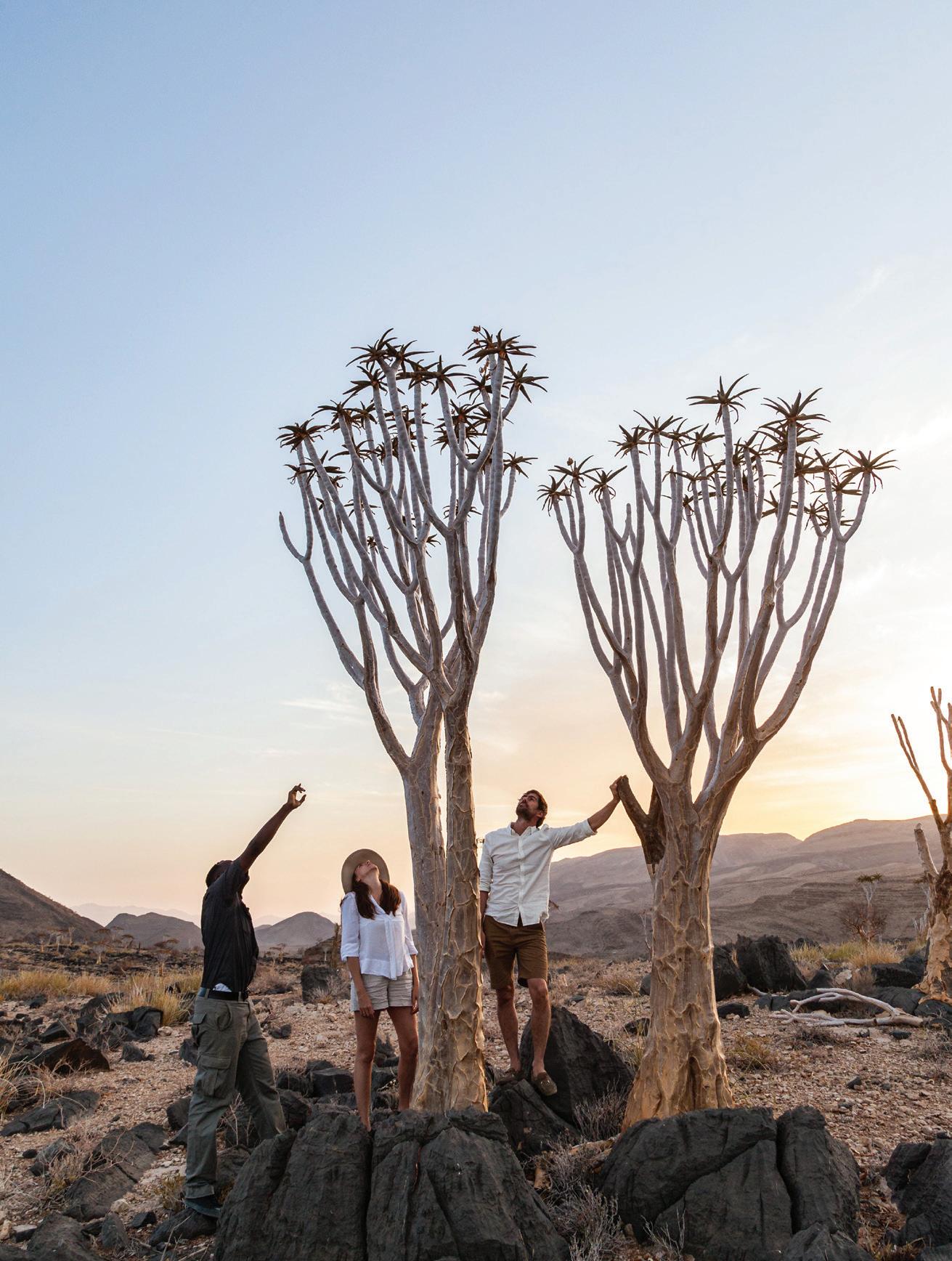









is published by Venture Media in Windhoek, Namibia www.thisisnamibia.com
Tel: +264 81 285 7450, Unit 1, Wasserberg Park, 1 Jan Jonker Road PO Box 21593, Windhoek, Namibia
EDITOR Elzanne McCulloch elzanne@venture.com.na
PRODUCTION & CONTENT MANAGER Le Roux van Schalkwyk leroux@venture.com.na
PUBLIC RELATIONS Elzanne McCulloch elzanne@venture.com.na
LAYOUT & DESIGN Liza de Klerk liza@venture.com.na
CUSTOMER SERVICE Bonn Nortjé bonn@venture.com.na


TEXT CONTRIBUTORS
Pompie Burger, Le Roux van Schalkwyk, Lee Tindall, Dirk Heinrich, Elzanne McCulloch, Helga Burger, Charene Labuschagne, Gitta Paetzold
PHOTOGRAPHERS
Elzanne McCulloch, Pompie Burger, Le Roux van Schalkwyk, Dirk Heinrich, Charene Labuschagne, Tina Vinjevold, Chris Botha, Gitta Paetzold
Travel News Namibia is published quarterly, distributed worldwide via Zinio digital newsstand and in physical format in southern Africa. The editorial content of TNN is contributed by the Venture Media team, freelance writers and journalists. It is the sole property of the publisher and no part of the magazine may be reproduced without written permission from the publisher.
All information and travel details are correct at the time of going to press. Due to uncertain circumstances, this may have changed after the date of publication. Please check businesses' individual websites for up-to-date details.
Winter 2023
Industry partners:

To advertise in Travel News Namibia or any of our other publications, contact Elzanne McCulloch +264 81 367 3583 | elzanne@venture.com.na | www.venture.com.na




Venture Media is the pioneer of Namibia tourism promotion. We are the leader in spreading the tourism word around the world. We distribute accurate, credible, up to date and regular tourism-related information on paper, in social media, on the World Wide Web, and on mobile apps. We have reached hundreds of thousands over almost three decades. Be part of our community and let’s do it together.




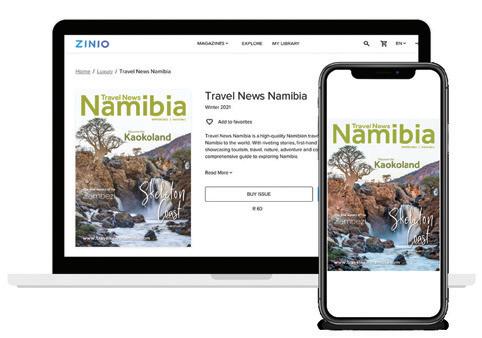
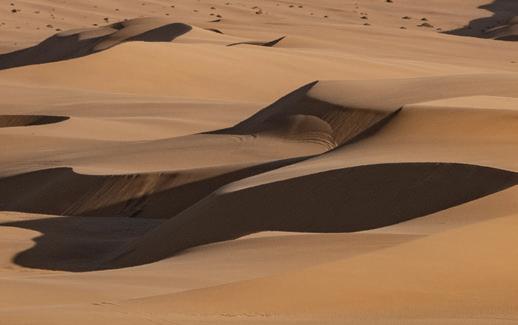




We focus on telling and sharing STORIES THAT MATTER across our various magazines and digital platforms. Join the journey and share your stories with audiences that understand and value why certain things matter.

Why ethical business, conservation, tourism, people and communities matter. How these elements interrelate and how we can bring about change, contribute to the world and support each other. Whether for an entire nation, an industry, a community, or even just an individual.
WWW.VENTURE.COM.NA or email us at info@venture.com.na for a curated proposal




Ifound myself surrounded by a large crowd of tourism industry professionals recently. We were crammed into a conference room, seated in front of a stage awaiting the next speaker. It was the Tourism Tech stage at the ITB 2023 in Berlin, Germany. I remember thinking: “Why aren’t any of us wearing masks? This seems strange.” Yet the moment was a testament to how quickly things change. A year before, the ITB was a virtual event and people logged in via their laptops from around the globe. Yet here we were, such a seemingly short time later, 160,000 visitors at the world’s largest tourism industry event.
The four-day trade fair was an interesting amalgamation of thought experiences. New things were certainly learnt, but the crux of the narrative proved to me that Namibia has always been ahead of the curve when it comes to what is important in tourism. Bigshots at Booking.com, Airbnb, Tripadvisor and Google showed us what the future of tech and tourism had to offer, and it was great getting some insights into what will be required to market tourism professionally in the coming years by making best use of these emerging technologies and realising which trends will solidify into must’s and which are likely to pass. We walked away from the ITB with an understanding of which mediums and content dissemination styles will be most important in the coming years. But do you know what we learned will never change? The importance of stories.
And not just any stories, but stories that evoke the new core principles of travel that future generations, and current travellers, are looking for. Conscious tourism. Tourism that is responsible, sustainable and a positive driving force. What people need now, since they have ditched the masks and the social distancing, is to know that their travels will not negatively affect the world. In a time where travel costs, especially for long-haul destinations such as Namibia, are incredibly high, travellers need to know that their dollars are well-spent.
The emphasis on positive tourism trends thus leaned towards sustainable travel. Something Namibia has placed in the highest regard for decades. As we look back over the past 30 years of Travel News Namibia we can see the trends consistently lean towards this very core of what Namibia’s tourism industry should be – high yield, low impact.
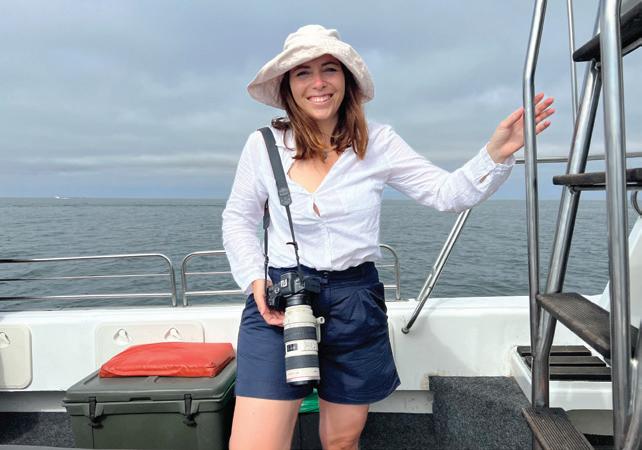

For our visitors who are so inclined, Namibia offers the very best in conscious tourism options. And the best way to experience these offerings, and to make sure that you get the most out of your long-haul travels, is to adopt the art of Slow Travel.

Slow travel through Namibia offers exceptional experiences. The country's rugged terrain, vast landscapes and stunning wildlife make it an ideal destination for travellers seeking to disconnect from the hustle and bustle of modern life and immerse themselves in nature. To fully appreciate the beauty and tranquillity of Namibia, it is best to take things slowly. Make conscious decisions. Travel with purpose. Stay longer, explore more.
With love from Namibia,
Elzanne McCulloch@elzanne_mcculloch


Imagine a flat tire in the middle of the Namibian bush, while a young elephant bull is approaching…and that was only the beginning of three exciting days at Etosha Heights, a private game reserve, bordering the famous Etosha National Park.



We joined students and researchers from the Namibian University of Science and Technology in releasing two cheetahs into the wild, searching for GPS-collared elephants and witnessed the passion of our Namibian youth for conservation. And we kept the microphones rolling throughout to bring you another story about our favorite topic: Namibia!
The land of vast spaces, of contrasting landscapes, of desertadapted elephants, Omajova mushrooms and glorious sunsets. The land of stories galore.
In our podcast ‘Namibia hören’ we take a look behind the scenes



of the most exciting places. And we meet people who care deeply about this country. Discover Namibia with us and share our love for this beautiful land.
We showcase our unique natural environment and tell you about Namibia’s conservation. We find out how charcoal or beer made in Namibia finds its way to foreign markets. Or what makes Kapana or Zambezi bream so special? And what role sports, music and politics play here. In short, we take you on a journey through Namibia.
Want to join the world of Namibian wonders and beauties? Simply tune in to Hitradio Namibia’s podcast ‘Namibia hören’. No need to worry about missing out because of language restraints – the podcast is a mix of German and English.
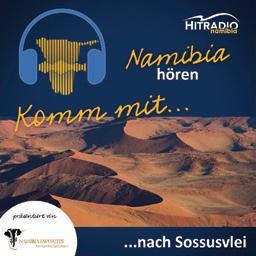

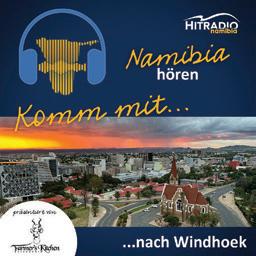

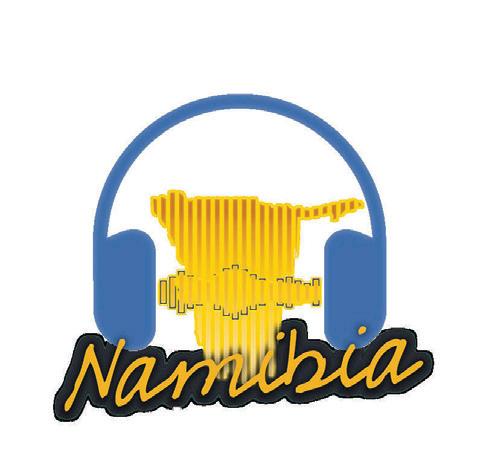




10 BUSH TELEGRAPH News from the tourism industry

18 SHOPPING for smart souvenirs

21 NAMIBIA’S HIDDEN HERITAGE SITES Featuring the Rhenish Mission Church
28 WINDHOEK SIGHTSEEING The best of both worlds
31 LIVING WILD Birds of a feather

32 CHECKLIST for slow travellers
34 CYMOT Celebrating 75 years
37 10 THINGS about Rhino conservation in Namibia
44 DESERT BREEZE Desert views to die for
47 THE TNN PLAYLIST Bush Diving
48 TREES OF THE NORTHEAST get to know the Baobab
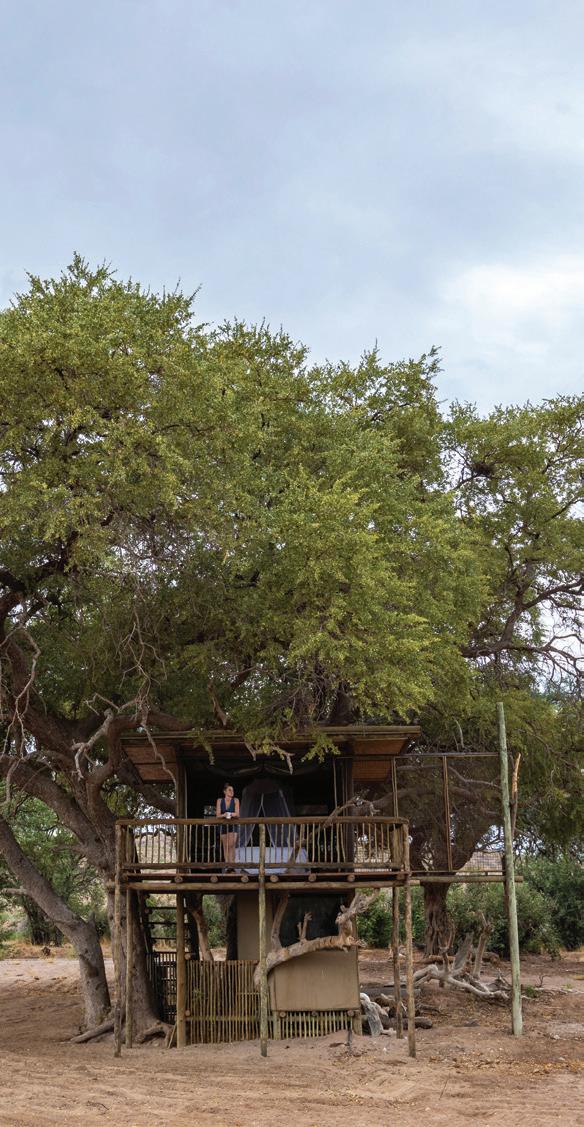
54 K9 UNIT The paws on the ground
60 FLYNAMIBIA SAFARI with EES
62 35 YEARS OF HAN Some roads well travelled, many more still to create
64 BIRDING WITH POMPIE three wise men from the west
70 LOOKING BACK 30 years ago in the pages of Travel News Namibia

The African Youth in Tourism Innovation Summit is an important event that provides African youths, start-ups, and small enterprises with a platform to pursue opportunities in the tourism industry. The event aims to create a network of support that maximises their leadership potentials, drive transformative change in their societies, and equip them with the necessary skills and resources to impact their world positively. The summit also provides career development opportunities for those interested in pursuing careers in tourism-related fields. This year's event will take place in Swakopmund, Namibia from 30 May to 2 June and is expected to attract hundreds of participants. It presents an opportunity for young entrepreneurs to showcase their tourism-related businesses and projects to the global marketplace to find the support they need to grow and succeed.
 Le Roux van Schalkwyk
Le Roux van Schalkwyk

Namibia Wildlife Resorts (NWR) has been honoured with the PMR Africa Diamond Arrow Award for Companies Doing the Most for Conservation and Tourism in Namibia. This award recognises the excellence of NWR in promoting conservation and sustainable tourism in Namibia. NWR operates several campsites, lodges, and resorts in or near protected areas, including national parks and reserves. The company has implemented eco-friendly practices such as solar power and waste management systems and has partnered with conservation organisations such as the KAZA TCI (Kavango Zambezi Transfrontier Conservation Initiative) to support conservation efforts in Namibia.


Team Namibia and the Namibia Tourism Board (NTB) have signed an MoU to enhance cooperation and collaboration. The agreement is aimed at boosting domestic travel and the local economy. The head of marketing at NTB, Charmaine Matheus, acknowledged the potential of tourism to create jobs, enhance infrastructure, and reduce poverty and inequality. Matheus also stressed the importance of supporting Namibians by promoting the local tourism industry. This agreement will create new opportunities for emerging economies and developing countries like Namibia, strengthening the country's economy and contributing to the conservation of natural and cultural assets.
The Namibia University of Science and Technology (NUST) has partnered with Namibia Wildlife Resorts (NWR) to provide training to enhance the skills of 634 NWR employees in the hospitality and tourism sector. The goal of the partnership is to improve customer service and culinary arts, ultimately benefiting Namibia's tourism industry.
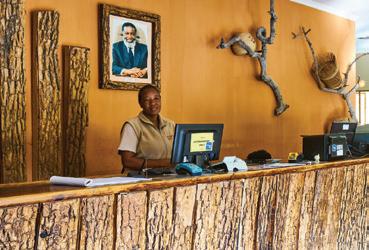

NUST Vice Chancellor Erold Naomab explained, "NUST and NWR responded to the need to enhance the skills of employees to improve in customer service and culinary arts. It is on this ground, NUST saw it befitting in providing this training because we have been at the forefront in making a significant impact on the industry through skills, human capital and state-of-the-art infrastructures for both theory and practical training."
Naomab added that NUST is committed to providing tailormade courses designed in consultation with the industry to meet the needs of both public and private sectors. He emphasised the responsibility of higher learning institutions to
provide capacity building through research, innovation, and training. "Hence, we must offer courses that are relevant to the improvement of service delivery in the tourism sector," he reiterated.
Matthias Ngwangwama, NWR's Managing Director, expressed his excitement for the partnership and the benefits it will bring to NWR employees and the tourism industry. "We are excited to partner with NUST, as it is our goal to provide our employees with skills that will enhance their performance in the hospitality industry. We are proud to have the opportunity to work with NUST to achieve this," he said.
So far, 75 employees have received training in customer care, while 55 have been trained in culinary arts. Another 75 employees will start their training this week, with the remainder receiving training as required. The partnership between NUST and NWR highlights the importance of collaboration between educational institutions and industry to improve service delivery and promote economic growth. TNN

 Text & Photographs Le Roux van Schalkwyk
Text & Photographs Le Roux van Schalkwyk
The saying goes that of all the roads you travel, make sure that some of them are dirt. Only, around here, most of the roads are. Deep in the south of Namibia, gravel roads and jeep tracks run like veins through the desert landscape. These roads connect destinations like Sesriem to Lüderitz or the Fish River Canyon. They are often looked upon as a means to an end instead of being part of the journey.
Let’s start with the road rumoured to be the most picturesque of all the scenic drives in the country. The D707 begins at an inconspicuous turnoff, regardless of which direction you take it from. At the northern end, the undistinguished turnoff forms part of the farmyard of Spes Bona, a classic farmhouse of Namibia’s south. Unremarkable as the scenery seems at first, the pastel blue and purple mountains gradually give way to large swathes of land. The road cuts a line through the desert with the massive red dunes to the west and the towering peaks of the Tiras Mountains to the east. In between, plains sparsely dotted with gemsbok, ostrich and springbok.
The odds are, if you have chosen to take this scenic route, and rented a self-drive to spend serious time off the beaten track, the philosophy of slow travel should come on autopilot. And that is precisely the default setting that ought to be selected once you hit the gravel of the D707.

Embrace the art of doing nothing: Part of the joy of slow travel is taking the time to simply be in a place. Find a place where
you can see a long stretch of the road. Stop the car, find a comfortable spot to sit, pour coffee from your flask and watch the world go by. An added bonus is seeing another car slowly making its way along the seemingly endless road.
At its southern end, the D707 comes to a grinding halt at the T-section with the C13 to Aus.
Commencing from the one-street town that is Helmeringhausen, the stretch of C13 that winds its way to Aus should also not be rushed. Slow down your transportation: If you are in a rental car, chances are there’s a blood-curdling alarm that goes off if you exceed the speed limit. Use that to your advantage! Driving slower is safer and gives you more time to look around.
As you pass the sign welcoming you to the Lüderitz District when heading south, the most scenic part of the drive unfolds before you. From higher ground, a sweeping stretch of road curves gracefully to the right, revealing a breathtaking vista in the far distance as the road begins to ascend once more.





Make sure to stop at the unusual Tower of Tiras. The oddlooking tower on the Neiseb farm was designed and built by Siegfried Schnebel, a former maths and science teacher. It is a wind pump seemingly made from scrap iron, intended to provide water for fruit orchards and livestock fields. The tower was supposed to use canvas rather than solid metal blades, apparently to handle strong winds better. Though never used, the contraption remains an impressive feat of engineering and a good reason to stop and look.
Instead of the C13, heading south from Helmeringhausen the C14 is the better option when travelling to the Fish River Canyon. Passing through the historical village of Bethanie and ending at Goageb, a former railroad station turned into a ghost town, the C14 will take you to the B4 tar road.

About 20 km from Helmeringhausen the road crosses the Konkiep River and continues alongside the dry riverbed all the way to Goageb. Unlike the other two roads that are known for their vast plains, this route highlights the beauty of undulating hills. Although not as well-known, the scenic vistas to be had from this road are captivating in their own right.
Don’t be rushed, connect with people: While this area is sparsely populated, the quirky settlement of Helmeringhausen with its hotel and shop or the little town of Bethanie with its old churches and friendly inhabitants, offer great opportunities to talk with locals and learn about their way of life. Strike up conversations to find out more about these settlements or why people choose to stay here. You might just be surprised by what you hear and even get the lowdown on a sight to visit that is not on a tourist map.
Namibia is meant for slow travel. Take your time to appreciate the stunning landscapes, unique flora and fauna, and the rich culture of the country. Instead of only visiting the typical tourist attractions, try venturing off the beaten track and exploring some of Namibia's lesser-known areas. This will give you a chance to experience the country's unique culture and connect with the locals in a more genuine way.
Don't let the rush of everyday life follow you on your holiday. Slow down and take in the breathtaking scenery of Namibia's south by allowing yourself ample time to explore. TNN
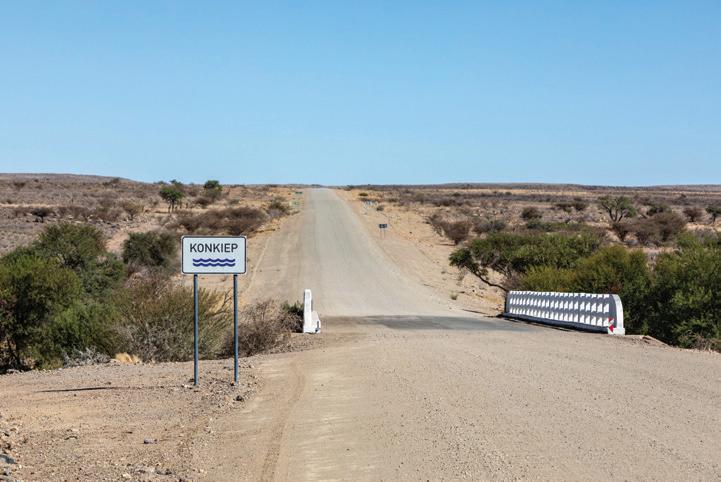

The saying goes that of all the roads you travel, make sure that some of them are dirt.
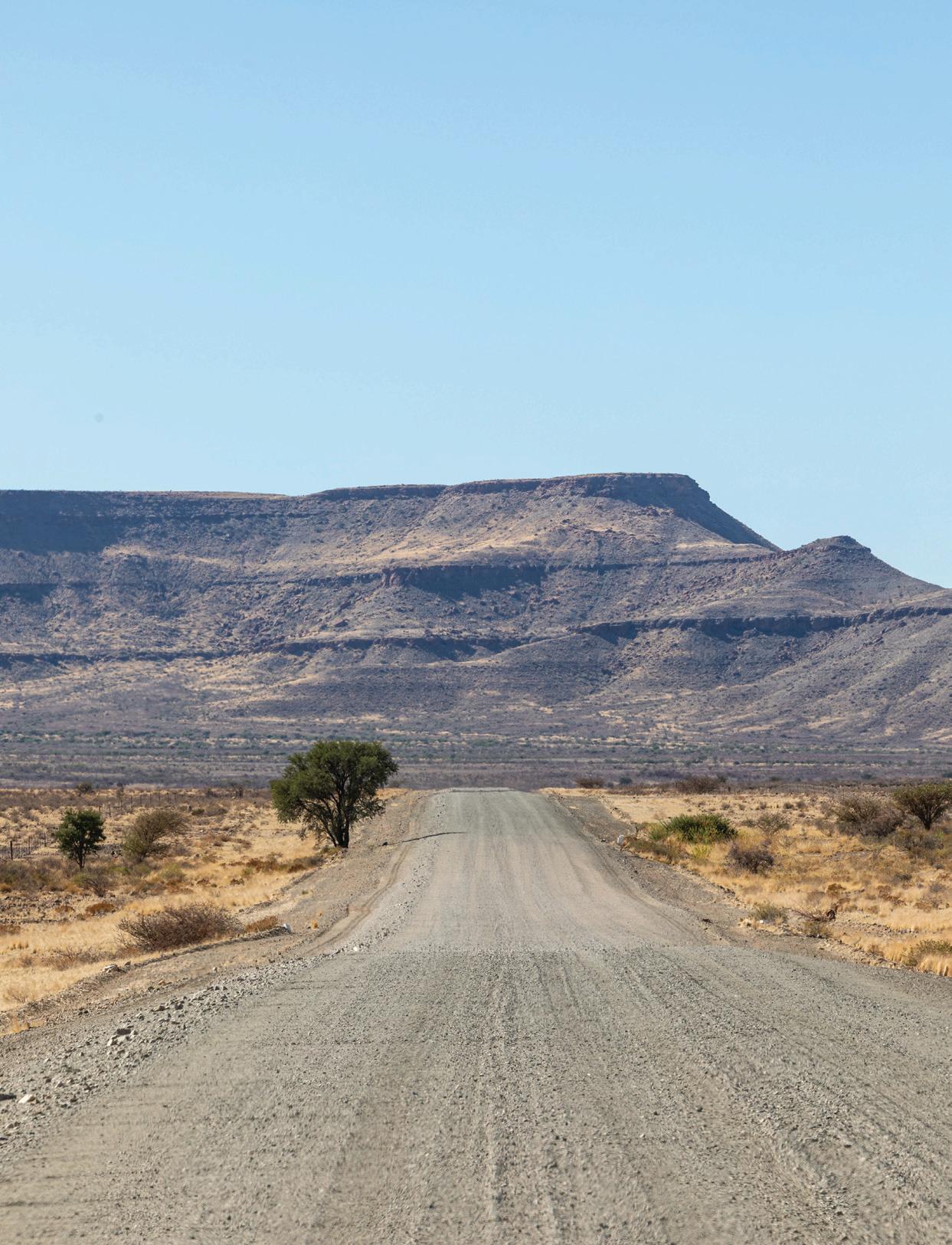

The land of endless horizons, as Namibia is fondly known, is filled to the brim with beautiful crafts and creations. Traditional woven baskets and clay pots hail from our northern regions, artisans having perfected the craft handed down from one generation to the next. Wherever timber is abundant, wood carving has been mastered and, thanks to the influence of some Zimbabwean expats, wire and bead figurines are found in great numbers in the capital. Damaraland boasts incredible jewellery items, created and sold by descendants of the Ovahimba people. Swakopmund offers a handful more commercial crafts, curated from the far corners of the country.
Be it to showcase the essence of your travels to friends and family back home, or as a personal reminder of a great holiday, souvenir shopping is an essential part of an adventure to foreign lands. Buying indigenous arts and crafts comes highly recommended, if you have the luggage allowance or budget to ship bulky baskets and ceramics. While Namibia offers souvenirs as plentiful as our beautiful sunsets, small businesses selling novel lifestyle items have also sprung up like the lilies in the desert after good rains. You are sure to fall in love with a wood carved elephant and authentic Himba bracelet, and by all means, support the crafters. That being said, here is a run down of practical gifting options, should you choose to treat yourself and loved ones at home with useful and long-lasting memories of your journey to Namibia.
Leon Engelbrecht Design is a small, proudly Namibian design studio that creates handcrafted leather goods and provides professional interior design services for private and corporate clients. Leon’s creative journey started over four years ago when he jumped the corporate ship and forged a fresh and creative path for himself.

All leather items are individually handcrafted and sewn by hand using traditional tools and methods. LED’s focus is on creating items and products that last and also reintroduce you to the artisan – so you know where, how and by whose hands your products get made. They are shipped worldwide.
FIMBI
Leather bags are forever, and in the case of Fimbi they are forever stylish also. Located in the loft of the Namibia Craft Centre in the heart of Windhoek, Fimbi specialises in handbags, wallets, belts and bags. Owner Elsie Imhof designs and manufactures Fimbi’s timeless handbags right here in Namibia along with four local women, and they really are crafted to international standards. Fimbi draws inspiration from the environment, which is reflected in their broad and generously cut, meticulously stitched and ultra chic leather pieces. Their range is the leather lover’s daydream.
Windhoek: Namibia Craft Centre

BEE-TIQUE HOTEL

By now we all surely know the importance of bees in our greater ecosystem, but how does the average Joe go about supporting bees? Incorporating a BEE-tique Hotel at home is a great place to start. One solitary bee does the pollination work of 100 honey bees, which is why it’s essential to give these difference makers a safe place to rest and reproduce. BEE-tique Hotels are adorably crafted blocks, fashioned with a roof and plenty of cavities for solitary bees to make a home. Their current offering includes pretty pastel high-rise hotels and Fachwerk-style homes with reeds that provide the cavities. These are a great addition to your outdoor decor, as well as a delighted conscience.
@beetiquehotel


Petra Naruses is one of the many success stories of the Namibia Craft Centre. She started out as a shopkeeper, eventually taking over the business and adding her very own flair to the product offering. Together with her daughters, Petra creates by hand each of the striking lampshades, delicate jewellery and funky mobiles sold at Hasegurure & Wirebeads. The lampshades and mobiles in particular are unlike anything else at the Craft Centre, boasting incredible detail and handicraft, right on par with aesthetics. Little wonder she enjoys creating them most.
Windhoek: Namibia Craft Centre
@namibiacraftcentre
Accessories complete any outfit, but a handbag is utterly essential! Just because we need them to carry all our things is no excuse for the bag to be drab. Goddess Ma are specialists in beaded handbags, every colour, shape and strap length or style imaginable. Sporting one of these hand-made bags is sure to elevate any outfit and garner compliments. The Goddess Ma range features structured, bucket-like bags as well as their more malleable sister. Think chequered, butterfly accents, pearl bead handles and heart-shaped bags. Goddess Ma’s creativity is endless and the price point even more alluring.
@goddess_ma_
KÄME
Pronounced comma, this local hand made jewellery brand is rooted in the principle of a pause, to take your mindful time in every endeavour. Their core range includes Malas, the 108 beaded necklace used in spiritual practice. Kämə Malas are finished with genuine Namibian leather tassels, fit for manifestation exercises or simply to spruce up an outfit. Most recently they’ve added bracelets and sunglass chains constructed of semi precious stones, wood and glass beads to the offering. Kämə is determined to translate their pausing principles and love for Namibia’s gemstones into practical and pretty tools that we can all use to facilitate our own growth.


Kämə is available at The Red Shelf in Windhoek & Swakopmund as well as via DM on @kame.lifestyle
A wise man once said “Don't believe what you've heard, our hair is not dead weight, it is an extension of our being. We must take control of our power and nurture it, let it grow, and manifest it into greatness.” This is the motto of African Beard Gear, a brand firmly rooted in empowering men to embrace their identity. Their range consists of a rich beard balm in a classic tin container and fragrance-free beard growth oil. If you’re a fella that likes to maintain his grizzly, switch to this local brand for Namibian beards.You can shop for Afro Beard Gear at The Red Shelf.
@afrobeardgear

Namibian skincare for Namibian skin. It’s a no-brainer! Emssence is a local self-care brand with product ranges including bespoke amenities, a baby and new-mum line, and their trailblazing natural skincare range aptly dubbed PURE. Fans of gentle skin products made in small batches will find everything they need for a multi-step skincare routine, including cleanser, toner, serum, moisturiser and decadent body and massage oils. Subtle fragrances like calming chamomile and energising jasmine, to name a few, are attributed to the natural ingredients and essential oils that make up Emssence PURE formulas. Founder Marianne Labuschagne formulated and tested multiple batches before fine-tuning what is now the only skincare brand you’ll need on your vanity.
@ems.sence
Our Stores
WINDHOEK
Gustav Voigts Center Independence Ave.
+264 61 224 209
WINDHOEK
Nakara Factory Shop 3 Solingen Street

+264 61 429 107
SWAKOPMUND The Arcade
+264 64 405 907
www.nakara-namibia.com
TANNERY & MANUFACTURING
Leather made in Namibia - since 1980


Travelling to a new country is an exciting experience that requires thorough planning and research. It's common to spend hours poring over travel guides, blogs, and websites to find the most interesting and unique places to visit. However, even when exploring our own country, we're always on the lookout for new activities or hidden gems. Sometimes, these hidden treasures are right under our noses, but we don't even realise it.
The National Heritage Council of Namibia, mandated by the government, is responsible for preserving and protecting significant places and objects in the country. While some of these sites, such as the Christuskirche, Alte Feste and Fort Namutoni buildings, and the Quiver Tree Forest near Keetmanshoop, are well-known tourist attractions, there are many other fascinating national monuments that often go unnoticed due to their unremarkable appearance, or obscure location.

In this series, we highlight some of the lesser-known or under-visited national monuments in Namibia that are often overlooked by tourists.
The Rhenish Mission Church in Keetmanshoop, Namibia, is a true architectural treasure. It was built in 1895 by the local Nama people under the guidance of the Reverend Tobias Fenchel, and it still stands today as the oldest building in Keetmanshoop.
The original church in Keetmanshoop was built in 1890, but it was washed away by the Aub River during a heavy flood. Reverend Tobias Fenchel was entrusted with the responsibility of overseeing the reconstruction of the church, and he modelled the new church after the Gambach Church in his home town in Germany. The new church was situated on higher ground than the previous one, and it was spacious enough to accommodate up to 1,000 people.
Johann Keetman, an elder of the Rhenish Mission in Germany, generously donated 1,000 gold marks for the construction of the church. As a gesture of gratitude, the locals renamed their village, which was formerly called Zwartmodder, to Keetmanshoop. This new name was meant to honour Johann Keetman for his generous donation, as he had invested not only money but also hope in the project.
The Rhenish Mission Society played an important role in the development of Keetmanshoop, where the Nama Kaptein Tseib and his followers had settled in late 1866. The missionary Dr. Carl Hugo Hahn had requested the Society to establish a mission station here, and this marked the beginning of a long and fruitful relationship between the Society and the people of Keetmanshoop.
Today, the Rhenish Mission Church no longer serves as a place of worship, but rather houses the Keetmanshoop Museum. The building's square stone tower measures some 30 metres in height and elegantly narrows to an octagonally peaked tip, making it a true architectural marvel. The solid stone walls, bowed wooden ceiling, and pulpit also add to the building's aesthetic appeal.
In 1930, the European community in Keetmanshoop decided to build their own church, leaving the Rhenish Mission Church to be used exclusively by the African members of the community until 1961. From then on, the church fell into disuse and started to decay. However, in 1978, the building was repurposed as a museum.
In 1985, after the Keetmanshoop mayor, His Worship Kurt Johannesson, had the church fully restored at considerable expense, the Rhenish Mission Society let it to the Keetmanshoop Municipality. Even in the hottest summer, the church's interior remains cool, making it an ideal location for cultural events and other activities.
The Rhenish Mission Church in Keetmanshoop is situated on Sam Nujoma Avenue, and the district of Keetmanshoop is located in the Karas Region of Namibia. This building is not only a cultural and historical landmark but also a testament to the ingenuity and craftsmanship of the Nama people who constructed it over a century ago. TNN
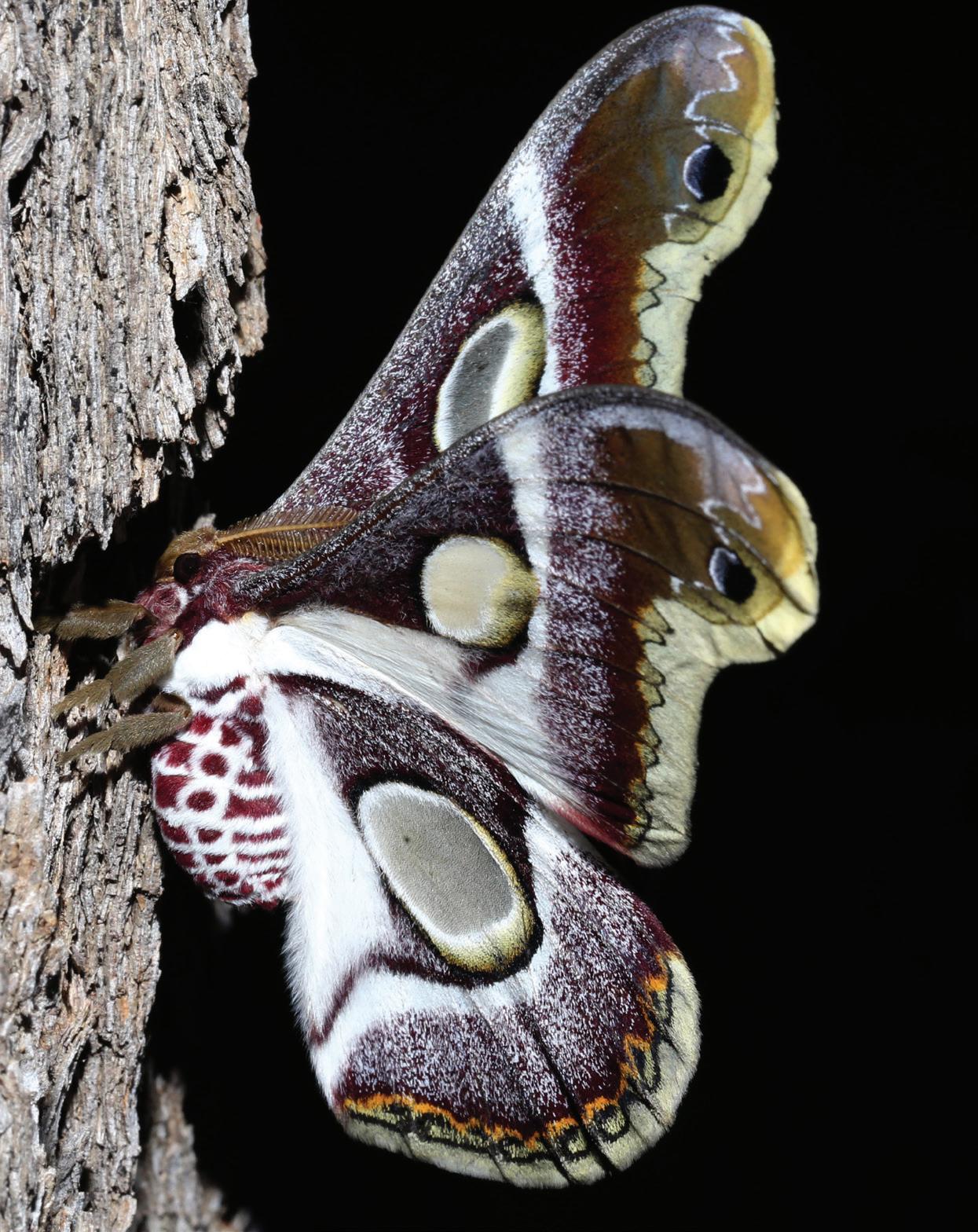
They are nature’s flying nocturnal artworks, short-lived, some well-known but others secretive and little-known, often overseen and attracted to light. The adults do not feed at all, and the larvae – caterpillars – are very selective regarding their food plants. A few species are a valuable food source for humans, such as the so-called “mopane worms”, whereas of some species the caterpillars and food plants are not yet known.
Once the often beautifully coloured adults, with their characteristic large eyespots mainly on the hindwings, hatch, after having lain dormant as a pupa for months or sometimes even years, their very short life has only one aim: to find a partner, mate and, for the females, find a suitable foodplant on which to lay their eggs. It is only in these three to four days in their adult life when we can be fascinated by the beauty of these creatures.

A person who has been fascinated by these nocturnal butterflies since he was a young boy growing up in Lüderitzbucht, Tsumeb and Windhoek is Dr. Rolf Oberprieler, author of the book “The Emperor Moths of Namibia” published in 1995. He went to school in Tsumeb and Windhoek, studied and worked in Pretoria in South Africa and moved to Australia 25 years ago. Now retired, he visited Namibia together with his wife, Beate, born in Windhoek, in January and February 2023 to look for certain emperor moths and their caterpillars and foodplants, as well as to meet friends and relatives.

1. Epiphora bauhiniae, the Southern African Atlas Moth, is arguably the most beautiful emperor moth in Namibia. It occurs in the north-central region from Windhoek and the Khomas Hochland north to the Otavi Mountains and from former Bushmanland to the Kavango region.
2. The females of the Bryk's Marbled Emperor lay their eggs on the foodplant in short rows, and each egg is attached to the leaf by a thin stalk.
3. Freshly hatched larvae of the Bryk's Marbled Emperor are a few millimetres long, black and bristly.
4. In the fourth instar the larva of Bryk´s Marbled Emperor is already a colourful and spiky-looking caterpillar.


5. A fully grown larva hanging from a leaf of its foodplant, as large caterpillars always do (they cannot stand on their fleshy legs, as often incorrectly portrayed in photographs). Soon the caterpillar will climb down from the bush and dig into the ground to pupate.
6. The larva of the Bryk's Marbled Emperor, is about 50 mm long and very well camouflaged as it feeds from the underside of the leaves of Elephant-root, its only known foodplant.

7. The caterpillars of the Western Marbled Emperor have become a food source around Windhoek in some years and are in competition with mopane “worms” (the larvae of the emperor moth Gonimbrasia belina) in the north. Women collect the caterpillars in large quantities, empty the intestine and dry them. In good years, as in 2020, they are sold by the women for extra income.

8. This species, the Western Marbled Emperor (Heniocha bioculata) are the most-seen and best-known emperor moth in the central areas of Namibia, where Black-thorn (Senegalia mellifera) occurs. The public often refers to this species as Hakkie Moth, because in some years they are abundant near and on hakkie trees. This species looks similar to Bryk’s Marbled Emperor but lacks the eyespots on the hindwings and has a different wing pattern.
9. A freshly hatched Bryk's Marbled Emperor male. Note the radar-like antennae, which he uses to find the female.
10. The Yellow Marbled Emperor (Heniocha flavida) is similar to Bryk’s Marbled Emperor but has larger eyespots on the hindwings and a dark brown or black patch on the back of the thorax. It is also very similar to the Southern Marbled Emperor, Heniocha dyops, in South Africa.
11. Ludia delegorguei, Delegorgue’s Playful Prince, is one of the smaller emperor moth species of the tribe Micragonini (princes), with a wingspan of 35-50 mm. The females are often found at lights during the night, but the males only very early in the mornings.
12. The Speckled Emperor (Gynanisa macromaja) in Namibia is a different species from the one in South Africa (Gynanisa maja). Around Windhoek its caterpillars feed on the leaves of Camelthorn (Vachellia erioloba). The moths are extremely well camouflaged on tree trunks but flash their large eyespots when disturbed, seemingly to frighten off predators such as birds and lizards by imitating the eyes of an owl.
Bryk´s Marbled Emperor (Heniocha distincta), a Namibian endemic, was one of his target species as its life cycle remained unknown, even 64 years after it had been described. Near Windhoek he managed to find males and females and, for the first time ever, also eggs and caterpillars on Elephant-root (Elephantorrhiza suffruticosa). The caterpillars pupated a few days later, and a first moth hatched at the end of February – the proof that they are indeed Heniocha distincta! Some of the larvae reared from the eggs also recently pupated, so that he could record and photograph the entire life cycle.
The information is needed for a new book on the emperor moths of southern Africa, on which Oberprieler is currently working. He has now recorded 31 species of these moths (classified as the family Saturniidae) to occur in Namibia, more than a third of the number present in southern Africa.


Efforts to find the Spotted Prince (Ludia corticea), a small species described in 1922 by Karl Jordan from one male and four females collected near Windhoek and never reported since, were unfortunately unsuccessful due to rain and cold weather disrupting the collecting efforts.


I was surprised of the beauty of the Southern African Atlas Moth (Epiphora bauhiniae), which I had never seen before despite the fact that it occurs in and around Windhoek. I most probably have seen Bryk´s Marbled Emperor and also the similar Yellow Marbled Emperor (Heniocha flavida) before but did not recognise them, because they look similar to the common Western Marbled Emperor (Heniocha bioculata) but have four eyespots on the wings, two on the forewings and two on the hindwings (H. bioculata has only two, on the forewings). One has to take a close look at these jewels of the night to spot the differences between the different species.

The Namibian emperor moths habour yet more surprises. For example, according to Oberprieler the Speckled Emperor found here is a not the same species as the one in South Africa (Gynanisa maja), and it is therefore necessary to take a closer look at its caterpillars in all their developmental stages as well. TNN
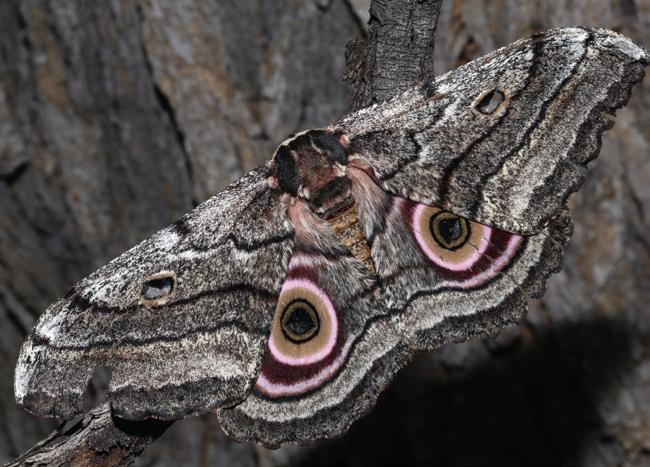
Dr Rolf Oberprieler - For the first time at the end of January 2023, Dr. Rolf Oberprieler, author of the book “The Emperor Moths of Namibia”, found the eggs and caterpillars of the Bryk´s Marbled Emperor, a Namibian endemic, outside Windhoek on a farm in the Khomas Hochland. Here he is looking for the larvae on Elephant-root, the only known foodplant of the species.

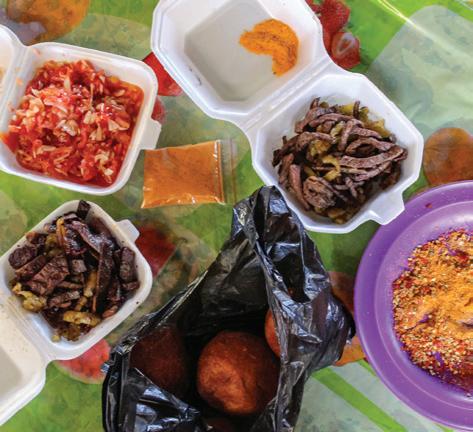
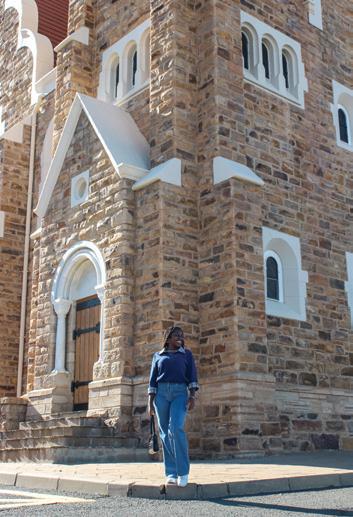




All aboard for the Chameleon Safaris city and township tour! Buckle up for a half-day’s worth of essential Windhoek sightseeing, Namibia’s favourite street food and a feel-good pitstop along the way.
The city and township tour begins on Windhoek’s lively high street, Independence Avenue. After boarding a comfortable air-conditioned minibus, the first stop is Christuskirche, the iconic historic church that dominates the capital’s skyline, uniquely situated in the centre of a traffic circle. Designed by Gottlieb Redecker, the church's German colonial origins, along with a few fun facts from the Chameleon Safaris guide, offer insight into Namibia’s past.
Hop across the road to the Independence Memorial Museum, a fascinating and iridescent structure. The museum tells the story of Namibia's long journey to freedom. The exhibits are both informative and moving, and they provide a deeper understanding of the country's past and present.
On to the Parliament Gardens, a sprawling lush complex surrounding the historic parliament building, also known as Tintenpalast. This neoclassical building was also designed by Gottlieb Redecker. It houses the National Assembly and National Council.
From here the tour ventures out of the city to Katutura, a vibrant and bustling suburb that is home to a large number of Windhoek's residents. The drive of roughly 20 minutes takes you through the north-western part of the city. Enjoy the ride and view the capital from the mini-bus. Once in township territory, streets are lined with small businesses, informal
shops, barbers and hair salons, car washes and meat cutters. In these streets dogs and taxis reign supreme. The Katutura lifestyle can be observed as the tour makes its way to the Single Quarters Market.
Single Quarters is a hotspot for locals to shop, eat and socialise. Local grub is the main attraction. Kapana is Namibia’s favourite street food, and the best thereof is said to be served right here at Single Quarters. Paper thin slices of beef and fat are seared on a hot plate over an open fire, seasoned with the all-important Kapana spice, a unique blend of sweet, spicy and savoury flavours. Take a seat at a plastic table, order some fresh African salsa, and gobble down your kapana with vetkoek, i.e. deep-fried bread balls.
Satisfied by the scents and sights of Katutura, the tour continues to Penduka, a women's project located on Goreangab Dam. Penduka is a long-standing project that supports female crafters, many of whom have hearing and sight disabilities, by providing training and employment opportunities in sewing, embroidery and other handicrafts. At Penduka you can participate in a batik workshop or go for a paddle boat ride on the dam. Either way, a stroll through the souvenir shop is essential. Purchase a few handmade gifts to take home.
The tour ends back on Independence Avenue, where you can continue exploring Windhoek's vibrant high street. The Chameleon Safaris city and township tour offers a unique experience, giving you a taste of the culture, sights and sounds that make Windhoek more than simply a stop-over or departure point, but an essential piece in the puzzle of understanding Namibia. TNN
Text & Photographs Charene Labuschagne


privileged to know some nature specialists who are founts of knowledge. Luckily, they are also amazing human beings who share their wisdom and their knowledge. Birds of a feather flock together. As this story is about our birding experiences over the years, that seemed like an apt segue.
When our daughter was 21 days old, she had her first day out birding! At that tender age her interest was really limited to sleep and milk. Mine was only just slightly broader, but the emphasis was heavily on sleep. Connor, though not quite three years yet, had a wild and abundant curiosity with a hint of creativity. Murray was excited to have an opportunity to learn from one of the best and to be out in the field. He has an insatiable thirst for learning and an exceptional ability to retain information. It is both admirable and intimidating. Our children have this, too, in various ways – it is no less impressive with them.
We had just returned home from Swakopmund where we introduced our new baby to family and friends and to rest after her dramatic entry into the world. She met everyone and we did very little resting.
My parents and family friends came to visit us shortly after our return, as there had been some amazing rainfalls in the middle of February and it meant that fauna and flora would be changing rapidly. There is nothing more magical than a desert transforming after rain.
This day was reserved for raptor trapping and ringing – an exciting process, which would allow us to catch and assess them, as well as ring them for record-keeping and data collection. One tool that is used to catch raptors is a bal-chatri: a small wire cage, with an endless number of selftightening, noose-like strings attached. A mouse or rat is placed in the bal-chatri to lure the raptors in. Once they come to grab the bait they get entangled in the strings, unable to fly off. This is where the ringer comes in, with (hopefully) gloved

hands, and untangles the bird, while ensuring it can’t take off. Birds are measured, weighed, the condition is checked and they are ringed. The data and ring number are noted, and then the bird is free to fly away. Should it be caught again, the data can enable us to see how far the bird has gone, where it has come from and other interesting facts.
This was one of the first times we had gone out and, as mentioned, the degrees of excitement among us varied.
A significant amount of time was spent getting ready, prepping equipment and having discussions on how, why and what to expect. The rains in mid-February had created a tapestry of shades of green all across the desert.

Connor was beyond excitement at the prospect of catching a bird, but most of all the bal-chatri enchanted him. He was trying to figure out how it worked, where the loops came in and how the mouse wouldn’t be able to escape. He had a small plastic duck he was playing with and tested how the contraption worked with that. Almost as exciting as when a real bird was caught later!
All systems go, as calmly as possible, so as to minimize all stress on the bird and get the data while enjoying the process.
Murray, with guidance from our friend, was hands on. At this stage he was learning the ropes so to speak, keenly paying attention and absorbing it all. Connor watched every step, and asked a myriad of questions. There is so much valuable data which we never think of, the feathers have a grading system and there are ways of placing birds in an age category.

Birding has been in our lives over the years, albeit on the periphery at times. While Connor has continued to have an interest and a curiosity for birding and the ins and outs, Grace has taken to it with a passion and with understanding. Perhaps this was the trip where the foundation for the love of birding was subconsciously cemented? At any rate, the experiences we have been able to share with our children are a true privilege. TNN
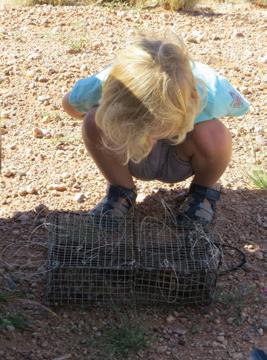
We feel tremendously

Namibia is a destination to be savoured and enjoyed at a leisurely pace. Don’t rush through the vast vistas in order to tick as much as possible off your to-do list. Curate your itinerary, stay longer, explore more. Here is a list of ways to enjoy Namibia more thoroughly as part of our ‘Slow Travel’ theme for this issue.
Take your time and avoid rushing from one destination to another. Slow down and enjoy the scenery.
Stay at locally-owned and operated accommodations, such as guesthouses, lodges or homestays.
Eat at local restaurants and try regional cuisine. Sample the traditional dishes and immerse yourself in the local culture. Meet the locals and learn about their way of life. Attend community events, festivals or markets.
Travel off the beaten path and explore the lesser-known areas of Namibia.
Join a guided tour with a local expert who can share their knowledge and insights about the area.
Walk or cycle through the wilderness and take in the sights, sounds and smells of nature.
Camp under the stars and experience the beauty of Namibia's night skies.
Take long drives through Namibia’s various national parks, stopping to take photos or enjoy a picnic along the way. Visit local wildlife reserves and learn about conservation efforts in Namibia.
Take a boat trip on one of the northeastern rivers and watch the sunset over the horizon.
Go on a guided hike in the mountains or canyons and learn about the local geology and ecology.
Visit local craft markets and buy handmade souvenirs or gifts.
Attend a traditional music or dance performance and learn about the local culture and traditions.
Volunteer at a local conservation project or community development program.
Take a hot air balloon ride and see the vast landscapes of Namibia from above.
Learn about Namibia's history by visiting local museums or heritage sites.
Take a mokoro safari on a river and see elephants, hippos, and other wildlife up close.
Attend a cooking class and learn to make traditional Namibian dishes.
Take a slow road trip through Namibia's many scenic routes, stopping to explore small towns and natural attractions along the way.
Take the time to find these special species:


Dune Lark

Rockrunner
Herero Chat
Hartlaub's Francolin
Monteiro's Hornbill
Rüppell's Parrot
Short-toed Rock Thrush
Cinderella Waxbill
White-tailed Shrike
Carp's Tit
These animals may not be as famous as the 'Big 5' elephant, lion, rhino, buffalo and leopard) but they are unique and interesting in their own right. Delve deeper into the natural wonders of Namibia’s biodiversity, take the time to try and find the Little 5:
Elephant Shrew

Ant Lion

Rhinoceros Beetle


Buffalo Weaver
Leopard Tortoise
Dune Lark





























In 2023, proudly Namibian company CYMOT celebrates 75 years of rich history, which has seen it become one of the most respected and well-known companies in the country. It all started with Helmut Brass, who began selling Autolite car batteries from his residence on Promenadenweg in Windhoek in 1948. Despite starting with nothing more than his family, his new Hudson, and £600 in debt, business soon took off.
In 1950, CYMOT opened its first official branch in Stübel Straße, Windhoek, and it continued to expand rapidly from there. In 1958, the company moved into a new building on Curt von Francois Street, where it imported and distributed Irvin Safety Belts, which were a groundbreaking safety innovation at the time.
Over the years, CYMOT has continued to expand its operations and product lines, including the opening of the Industrial and Mining Branch in Garten Street, Windhoek, and the Walvis Bay branch in 1984. In 2021, the company opened two new branches in Gobabis and Ondangwa, bringing its total number of branches to 18.

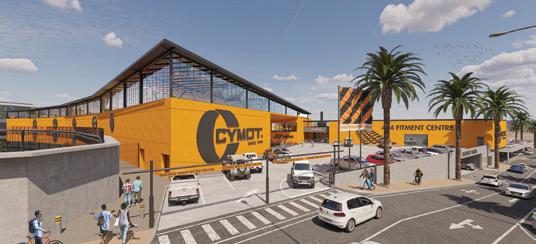



Throughout its history, CYMOT has remained committed to providing top-quality products and services to its customers,

as well as to supporting the local communities in which it operates. Over the years, CYMOT has grown and evolved, branching out into various industries such as agriculture, mining, and automotive. In 2002, the reins of the company were handed over to Axel Theissen, who took over as Managing Director from Claus Theissen, his father. Under his leadership, CYMOT continued to flourish, expanding its operations to Angola, and even acquiring ALERT Namibia in 2020.
In 2022, Axel Theissen stepped down as Managing Director after 20 years of service to the company. He handed over the reins to Ralph Ellinger, who took over as CEO. Under Ellinger's leadership, the company continues to expand its operations and invest in innovative technologies to better serve its customers. CYMOT's new flagship branch at the Hilltop Estate in Windhoek is just one example of the company's commitment to growth and innovation.
As CYMOT celebrates 75 years of existence, it looks back on its proud history and looks forward to a bright future of continued growth and success. The company remains dedicated to serving its customers and making a positive impact in the communities it serves. With a strong commitment to quality and innovation, CYMOT is well-positioned to continue its success for many years to come. TNN

Looking back on its proud history and looking forward to a bright future

1. Namibia is home to the largest population of black rhinos in the world, with over 1,800 individuals.
2. Rhino conservation efforts in Namibia have been successful in increasing the population of both black and white rhinos, with numbers rising over the past several decades.
3. Rhino protection and breeding programs, along with anti-poaching efforts, have been crucial in the successful conservation of the species in Namibia.
4. Community-based conservation initiatives, where local people are involved in protecting rhinos and their habitat, have been effective in reducing poaching and ensuring longterm survival of the species.
5. Namibia was the first African country to introduce "rhino trophy hunting" as a means of generating revenue for conservation efforts. With this programme, an incredibly small number of animals, past their reproductive age, are made available for hunting, which generates large amounts of revenue that can be put towards conservation.
6. The Black Rhino Custodianship programme has also shown successes, whereby black rhinos, legally owned by the State, are given to private landowners to foster and protect.
7. The Namibian government has taken steps to combat wildlife trafficking, including implementing stiff penalties for those caught illegally trading in rhino horns.

8. The country's tourism industry has also played a role in rhino conservation, with ecotourism and wildlife safaris generating revenue that is used for conservation efforts.
9. Namibia has a strong network of protected areas and national parks, which provide habitat and refuge for rhinos and other wildlife.
10. Ongoing monitoring and research efforts are crucial in ensuring the continued survival and recovery of rhinos in Namibia, and include tracking populations, monitoring reproductive success, and studying behavior and habitat needs. TNN
you might not

Photography Feature: Chris Botha



Chris Botha is a Namibian-born photographer whose love for photography has made the world around him come alive. He captures the beauty of his surroundings and makes life seem slow, steady and free. Chris's approach to photography is driven by his love for the creative process and the thrill of the chase. He says, "Anything is interesting if you look close enough. The more mundane, the more exciting the challenge to find that interesting shot."


Chris started out in stock photography. According to him, it taught him all the technical aspects of taking photos, but it took all the fun out of the creative process. He found that the subject and the look and feel were predetermined, and there was no fun in that. For Chris, going out not knowing what he will find is his inspiration.

Anything is interesting, if you look close enough. The more mundane, the more exciting the challenge to find that interesting shot.

His romantic and stylized view of the world through his lens captures the soft beauty of his daily surroundings – whether on the family farm, at one of Namibia's most stunning wilderness destinations, or even just at home. His approach to photography is a form of meditation, fully immersing himself in the experience, and sometimes he is lucky enough to be in the right place at the right time.
Chris Botha is an exceptional photographer who captures the beauty of life in a way that makes us stop and appreciate the world around us. His work inspires us to slow down, take a breath, and find the beauty in the mundane. TNN






ygge and wabi-sabi. These two foreign lifestyle and design philosophies come to mind at Desert Breeze Lodge. Perched on granite boulders bordering the Swakop River, overlooking dunes of the Namib Sand Sea’s proverbial beach-break with cosy comfort and quirky style, this lodge is completely unique to Swakopmund’s accommodation offerings, and arguably one of the most interesting in the country.
Hygge is a defining characteristic of Danish culture. Pronounced something like hoo-gah, hygge is the quality of comfortable conviviality, generating feelings of contentment and well-being from an all-encompassing cosiness. Seated by a wood-burning fireplace, lounging on a plush sofa with a dog-eared book while a blanket of coastal mist hangs over the landscape outside, few words manage to pinpoint the ambience quite like hygge does. Surrounded by natural timber details, curled up in bed with a picture frame view of the endless sand sea outside, hygge could very well be just as defining of Desert Breeze as it is of the Danish.
Similarly, a warm fuzziness rushes through your veins when spending a moment paging through the Desert Breeze guestbook. Pages and pages filled with comments and pen colours from all over the world, all praising the brilliant breakfasts, unique design, breathtaking views and unparalleled comfort of the lodge. A guestbook truly gives the best insight into accommodation establishments, and Desert Breeze’s repurposed photographic coffee table version speaks volumes of the hygge experience had by many on the bank of the Swakop River.
Whether staying in one of the twelve en-suite chalets, or sharing the self-catering villa with family and friends, or opting for a garden view from the Jungle Bungalow – comfort, cosiness and contentment are guaranteed. Desert Breeze not only meets every need from coffee, tea and mini-fridge facilities to wireless internet access, but due to its location on the outskirts of Swakopmund also offers welcome respite from the town’s bustling centre.
The lodge’s architecture captures you as you enter the property. Bursts of cobalt blue, burnt orange and lime green draw the eye
Hinto the smaller details. Rounded walls, angled roofs, organic wood beams and trusses all poetically juxtaposed by the pale granite they sit on. This is wabi-sabi, the Japanese philosophy that beauty lies in the imperfections of nature. As a design aesthetic, wabi-sabi has been translated into the simplistic and understated mixing and matching of influences.
Desert Breeze showcases precisely how seemingly unrelated items can come together, evoking a sense of adventure and grandeur in the most tasteful manner. Like visiting the home of a well-travelled friend, where shelves are filled with knickknacks from the other side of the globe and details are divinely influenced by exotic ventures. The design, decor and subsequent atmosphere of Desert Breeze generate similar wanderlust – only, you are already exactly where you ought to be.
The reception, lounge, dining area and viewing deck in the main area are lessons in wabi-sabi. Jute rugs and wall hangings, deep leather couches around a mokoro canoe repurposed as a coffee table, high ceilings with skylights, and yet another wood-burning fireplace. A larger-than-life granite boulder abstractly represents a rhino and commands the way to a delightful lunch or dinner in the open plan dining area. In the succulent garden, so synonymous with Swakopmund, or strolling through the basalt rock sculpture exhibits scattered all over the property, the longer you linger and marvel, the more details are revealed.
Perhaps the only part of Desert Breeze that cannot be translated or interpreted into new-age philosophy, is the view. First the steep bank of the Swakop River and then the apricot coloured dunes, like waves at low tide. Sossusvlei’s dunes might be bigger and redder, yet from the high vantage point of the deck of your Desert Breeze chalet, the masses of crescent hills of sand stretching as far as the eye can see are an experience completely in its own right. TNN
Tel: +264 (0) 64 406 236
Email: info@desertbreezeswakopmund.com

Website: www.desertbreezeswakopmund.com

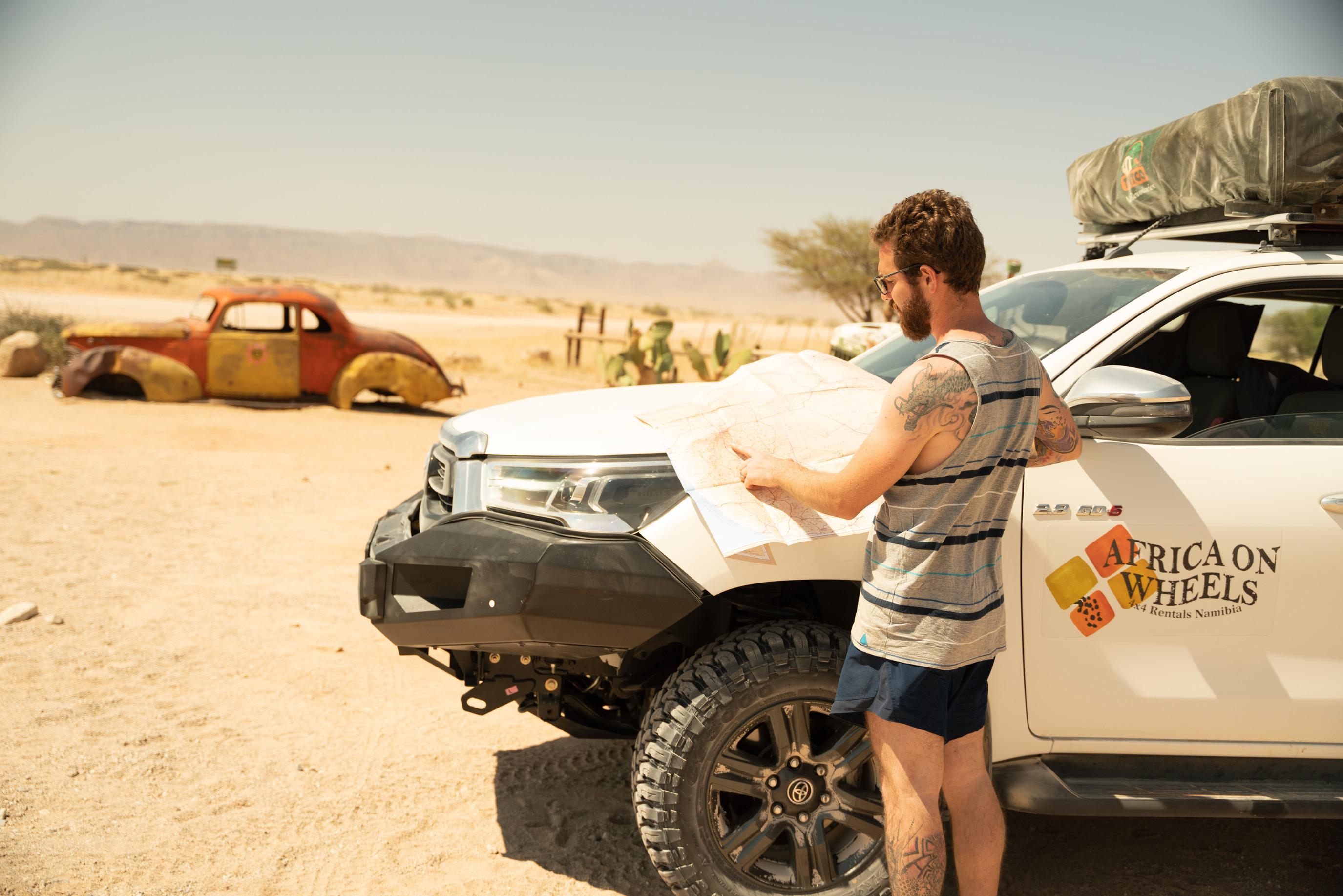


Let’s set the scene: You are in your car cruising through one of Namibia’s prolific national parks. It is either really early in the morning or mid-afternoon… Converse times of day, I know, but what they have in common is how you are feeling. You are tired. The coffee hasn’t been quite the kick you needed to get you up at dawn for the best possible game viewing, or a long day of traversing vast landscapes has got you a bit slumped. What’s playing on the radio? A podcaster with a droning voice telling you about the intricacies of silverware antiquing? Skip that. Rather pull up your Spotify app and press play on our Bush Diving roadtrip playlist, specially compiled to bring some much-needed up-beat vibes into the interior of your game-viewing conveyance. The right playlist can set the tone for your African adventure and get those excitement levels to their requisite heights… just in time for you to spot your next wildlife wonder!
Music has a powerful impact on our emotions and mood, and the right playlist can elevate our
spirits, improving our overall mood and wellbeing. Our Bush Diving Roadtrip Playlist aims to do just that with some timeless classics, some off-the-grid tunes you may not have heard before and a few local loves. All the songs have one thing in common – a distinctly upbeat vibe infused with African roots. African music is known for its vibrant rhythms, infectious beats and uplifting melodies, which can inspire feelings of joy, positivity and adventure.
Travel News Namibia’s Bush Diving Playlist
 By Elzanne McCulloch
By Elzanne McCulloch
As you journey through one of Namibia’s incredible game reserves, be it Etosha, Bwabwata or Mudumu, let our wild and wonderful themed playlist provide the perfect soundtrack to your adventure.
Sidenote: Be sure to turn down the volume on your speakers as soon as you are pressing the lower window button to take photos of the lions on the edge of Etosha Pan. There is nothing less cool than tunes pumping from a vehicle, disturbing the wildlife and your fellow visitors… no matter how lekker the beats. TNN

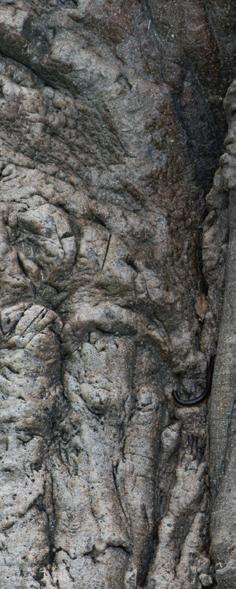
In this series we explore the beauty of trees with our beloved local nature-enthusiasts and authors, Helga and Pompie Burger. Each with a unique voice and opinions on how best to identify the trees of the Kavango and Zambezi, Helga and Pompie help us through the tricky trials of identifying northeastern Namibia’s most iconic flora.

The Baobab tree stands out above the rest: Massive and impressive, tall as well as wide with either a green lush crown or a distinctive silhouette, showing off its enormous thick trunk, branching into a few bigger branches which gradually divide into multiple small branches. The Baobab is an ecosystem on its own: it houses owl nests and squirrel families, it is a pantry for bats, and many insects and lizards find shelter in it. Elephants seek its shade…
- Helga BurgerThis is an easily identifiable tree, a trunk and flower and fruit and down under tree. If you cannot identify an adult tree you are stupid, but if you can identify a young Baobab, you’re a genius. It is unfair for one tree to have such beautiful shape, trunk, flowers and fruit. To make matters even worse, even a dead flower is a work of art.


 - Pompie Burger
Base of fruit shows remains of star-like leaves of calyx
Large pure white flowers hang like lanterns on a stalk
- Pompie Burger
Base of fruit shows remains of star-like leaves of calyx
Large pure white flowers hang like lanterns on a stalk
SCIENTIFIC NAME: Adansonia digitata
AFRIKAANS: Kremetartboom, Dorsboom
GERMAN: Affenbrotbaum
KWANGALI: Euyu
LOZI: Muvuyu
• A massive single-trunk tree
• The base of the trunk resembles the foot of an elephant
• Big candle flowers
• Large ovoid fruit the colour of olives
MAP GUIDE
Tree density in various areas
Main road
• Smooth grey bark looks like an elephant foot at the base
• Grotesque trunk, up to 20 metres in height and even circumference
• Branches are relatively thin compared to the trunk
• Leaves on the tip of branches are almost hand-shaped (5-7 fingers)
• Large pure white flowers hang like lanterns on a stalk
• Long white stamens with yellow tips
• Large olive green velvety ovoid fruit (300x100) on long stems is actually a berry
• Leftover of flower is often found on the tip of the fruit
• Base of fruit shows remains of star-like leaves of calyx
• Dead flowers on the ground a work of art of in itself
• Because of the flower’s weight it is often pierced by undergrowth
• Dried flowers keep their shape for a long period of time
This article is an extract from The unbearable beauty of trees: 56 magnificent trees of Kavango and Zambezi written by Helga Burger, published in 2020.
To order The unbearable beauty of trees , contact Bonn at bonn@venture.com.na

 Text Charene Labuschagne
Text Charene Labuschagne

Welcomed by handshakes and friendly introductions, arriving at Hobatere is like coming home. The journey begins from the moment guests enter the ≠Khoadi-//Hôas conservancy at the main gate, framed by two towers reminiscent of classic stone castles. Barely three kilometres into the conservancy, we spot the first wildlife. Stocky mountain zebras trot across the jeep track, shy to show us their striped pyjamas as they disappear between the mopane forest dotted with honey-coloured boulders.
The road meanders over rocky stretches, soon followed by the thick sand of the Otjovasandu River. And then come the lanky, longlived trunks of undoubtedly the largest mopane trees I have ever seen. After a long day on the road watching the scenery change from one idiosyncratic landscape to the next, Hobatere feels like an African fairytale painted by the impressionists.
At the reception area await sweet ginger welcoming drinks and refreshing hand towels, as we enter the main landing with a lounge as well as large polished wood bar, dining and outdoor seating areas. One by one, the waiting staff and managers – all community members from nearby villages – greet us with warm smiles. Everyone is made to feel like a guest of honour.
While the game-viewing deck overlooking a nearby waterhole and organic-shaped pool with a trickling water feature both beckon to be enjoyed, our suite for the evening awaits somewhere in the wild. We venture on a game drive with Martin just as a soft rain breaks over the conservancy. A few droplets could not possibly deter us from exploring what Martin calls the termite plains, or the tree house that will be our home for the evening. On the game drive we spot a curious herd of springbok, their coats moistened by the drizzle and juxtaposed by the bronze termite mounds that protrude like pointy hats from the level landscape. Two scavenging jackals dash through the shrubs, their prowess visible in the sunken shoulders, lowered head and stealthy jog to the next leftover feast.
Then come the birds in all their spotted and colourful glory. One of my favourites, the Lilac-breasted Roller, is perched picturesquely on a branch overhanging the road. These brilliant blue and purple feathered avians always seem to flutter off just as you’ve framed the picture through your camera viewfinder, right before you can capture them digitally. Yet it is in flight that this roller is at its most endearing, their technicolour plumage in full display. The Damara Red-billed and Monteiro’s Hornbill, both endemic to northern Namibia and southern Angola, showcase their impressive banana-shaped beaks on treetops. And the Blueeared Starling’s iridescent feathers catch the light filtering through the rain clouds above.
Our game drive ends ceremoniously with a sundowner gin and tonic and authentically Namibian snacks of biltong and homemade crisps. Parked on a wide open plain surrounded by soft peaks, remnants of the passed rain make for a brilliant sunset, so characteristic of this land. From here we observe the Hobatere
tree house, camouflaged under a treeline by its canvas and wood double-storey structure.
Here Martin bids us farewell, driving off in a cloud of dust as we investigate the storybook structure. In the shade of a tree, the Hobatere tree house is enclosed by a shoulder-high wooden fence, an essential barrier between guests and the wild ones that roam around freely. At its base, the tree house features an indoor gas-heated shower, flushing toilet and basin, complete with a window-framed view of the landscape that surrounds it.
Up to the second storey, where an expansive wooden deck overlooks the nearby waterhole, a secondary, smaller tree’s trunk protrudes the deck floor. When seated outside on classic canvas camping chairs, these two trees embrace you, solidifying the storybook experience.
As daylight fades, we dive into the three hefty cooler boxes comprising our drinks and dinner selection for the evening. The Hobatere team have simplified the semi self-catering experience, sparing no effort with a table-setting kit including white linen tablecloth, napkins, cutlery and crockery. A crisp bottle of Bordeaux is cracked, and we help ourselves to an aromatic butternut soup starter under the faint, ambient light of safariinspired lamps.
We have only just begun tucking into a platter selection of salads and crumbed chicken when the soundtrack to the evening commences. As if amplified over a speaker, the deep huff and puff of a male lion fills the silence. Roaring from the loneliest crevice of his soul, the lion’s call sends a spell of chills down our spine. The only thing louder than his call for mates is the audible thumping of our hearts. Without a moment’s hesitation the spotlight is projected into the distance. Surely he cannot be that close… As the floodlight fills a dark night and we survey to spot the calling cat, two red eyes appear merely 150 metres from the deck, and the faint shape of the lion’s reclining position confirms our suspicions – he really is that close!
After dessert, our only other companion at the tree house falls silent; the adrenaline rush simmers to a deep sleep after retiring to the mosquito net canopy bed. A sliding mesh door allows the midnight breeze to cool down the tree house sleeping quarters, with the added peace of mind that creatures are kept at bay.
Arising with the soft light of sunrise, the feeling of sheer isolation, of spending the night in a rustic tree house at the mercy of nature, the uncanny closeness to Africa’s most iconic cat and the splendour of great red wine and a wholesome dinner will forever remain etched into memory. Hobatere’s mantra rings true – we have become one of the pride. TNN

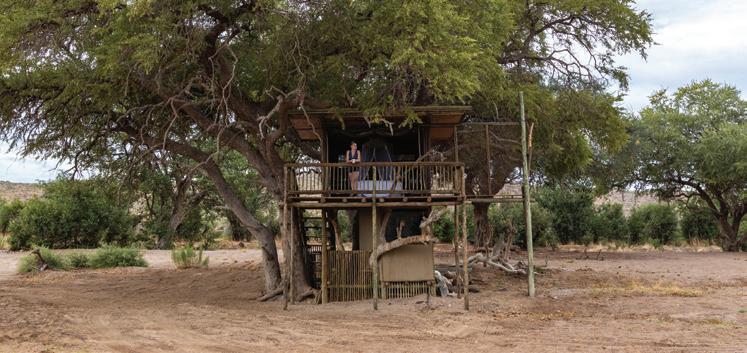



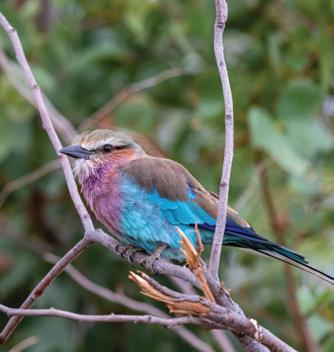




At a base in Waterberg National Park lives a special band of wildlife protectors. With a tough job, and through vigorous training and vigilant operations, this team is one of our country’s most successful contributors to the fight against wildlife crime.
Namibia's K9 Unit, managed by the Ministry of Environment, Forestry, and Tourism, is a highly trained team of canine officers and their handlers dedicated to protecting Namibia's wildlife and combating wildlife crime.
The K9 Unit was established in 2005 in response to the increasing poaching of elephants and rhinos in Namibia. Since then, it has grown to become one of the most effective tools in the fight against wildlife crime in the country. The unit is made up of a team of handlers and specially trained dogs who are deployed to wildlife crime hotspots across Namibia.
The dogs in the K9 Unit are specifically trained to detect wildlife contraband such as ivory, rhino horn, and pangolin scales, as well as firearms and ammunition. The dogs' sense of smell is many times more powerful than that of humans, making them a valuable asset in the fight against wildlife crime. The dogs are trained to track poachers through the bush, locate hidden wildlife contraband, and even apprehend suspects.
The K9 Unit's success in protecting Namibia's wildlife is due in large part to its close collaboration with other law enforcement agencies and wildlife conservation organisations. The unit works closely with the Namibian Police, Customs and Excise, and the Ministry of Fisheries and Marine Resources to intercept poachers and smugglers. The unit also works closely with conservation organisations such as the Save the Rhino Trust and the Cheetah Conservation Fund to protect endangered species.
The K9 Unit's success can be seen in the declining poaching numbers in Namibia. Since its inception, the unit has helped to reduce elephant and rhino poaching. The unit's work has also led to the successful prosecution of many poachers and smugglers. One of the greatest successes however, is the fact that the unit has been able to pre-emptively foil would-be perpetrators, before they could poach specially protected species.
In 2020, Standard Bank Namibia, donated a fully customised Toyota Land Cruiser V8 to the Ministry of Environment, Forestry and Tourism for use by the K9 Unit. The vehicle is equipped with special compartments in which to safely transport the canines to often far-off locations for deployment and has been instrumental in the overall success of the team. “Standard Bank Namibia operates by the brand promise, “Namibia is our Home, We Drive Her Growth”, and contributing to this special project is our way of lending a helping hand to ensure the protection and future existence of Namibia’s pride, our wild animals. Namibia’s wildlife is an integral part of the spirit of our country, as well as the tourism industry which is one of the largest contributors to our economy. Investing in Namibia’s growth also means protecting and nurturing what we already have. We are honoured to be a partner of the ministry and look forward to the positive impact we can have on our country through collaborations such as this”, said Magreth Mengo Head of Marketing.
Namibia's K9 Unit is a vital tool in the fight against wildlife crime in Namibia. The unit's highly trained dogs and their handlers work tirelessly to protect Namibia's wildlife, and their success in reducing poaching numbers is a testament to their dedication and hard work. TNN
 Watch a video and learn more about these special dogs and their handlers: https://bit.ly/3LBjUQl
Watch a video and learn more about these special dogs and their handlers: https://bit.ly/3LBjUQl

30 years of putting at Ongava
Close your eyes and come on a journey with me. A journey back in time. Imagine it's the year 1993. Whitney Houston’s I will always love you is probably blaring on the car radio as you drive, Bill Clinton is in the White House, Madiba has just received his Nobel Peace Prize and the western world’s most popular way of appreciating nature is flocking to cinemas to watch Jurassic Park. In our corner of the world, Namibia has just adopted its first constitution. Article 95 stipulates that the State shall actively promote and maintain the welfare of the people by adopting international policies aimed at, among others, according to Section 12 the “maintenance of ecosystems, essential ecological processes and biological diversity of Namibia and utilisation of living natural resources on a sustainable basis for the benefit of all Namibians, both present and future; [...]." This made Namibia one of the first countries to include provisions for environmental protection in its constitution.

At about the same time an idea takes root in the central north of Namibia, just south of the border of Etosha National Park. An area predominantly made up of cattle farms. It is here, in this vast and stunning bushveld landscape, that the ideology of a conservation-centred land use model takes shape and breaks away from the status quo. That was how the Ongava Game Reserve was born.
Ongava is a remarkable example of how cattle farms can be transformed into a nature reserve through hard work, dedication and a strong vision for conservation. This stunning reserve in Namibia covers an area of 30,000 hectares. Ongava is located just south of Etosha National Park, and its close proximity to the park has played a big role in its success.
 Photo
Photo
“There are times when solitude is better than society and silence is wiser than speech.”
Charles Spurgeon
The rehabilitation of degraded habitats in the opening stages of Ongava was marked by multiple setbacks. The major project involved removing internal fences and securing the external boundary, which was crucial to restoring the natural ecosystems and reintroducing indigenous species. The reserve’s first lodge, Ongava Lodge, was officially opened in 1993. The nature reserve’s tourism product was commitment to non-consumptive tourism, such as photographic safaris, from the very start.

Rob Moffett, GM of Sales & Marketing at Ongava, explains that the development of the reserve was not without its challenges. "Good fences make good neighbours”, he says, referring to the scepticism of park authorities in the early stages. The southern boundary of Etosha is also the veterinary coordinate, which is a double fence designed to reduce the risk of disease transmission between species. Ongava invested heavily in mimicking this boundary, building double fences on its external boundaries to avoid human-wildlife conflict. They had to keep their neighbours in mind, some of whom were still cattle farmers. After all, Ongava would be home to big predators.
Despite the challenges, Ongava's commitment to conservation and sustainable tourism has remained steadfast. Over the years, the reserve has tried to appeal to different segments of the tourism market. For example, an isolated Bush Camp called Himba was developed in a rugged, remote part of Ongava, but it was short-lived. Horse safaris were attempted in the 1990s but also proved unsuccessful. Little Ongava, the reserve's high-end luxury product, was built in 2001, followed by Andersson's Camp in 2007. The latter camp was intended to appeal to a broader demographic, including the self-drive market interested in Etosha. However, Andersson's struggled to find its feet. Ongava's hospitality principle is to be generous and fully inclusive, while the three-star market that Andersson's was trying to cater to needed less offerings and frills, and more accessibility at a lower rate.
Ongava has remained a bastion of conservation throughout, and its commitment to preserving wildlife habitats and promoting responsible tourism is stronger than ever. Moffett emphasises that Ongava's primary focus is on conservation and that tourism is a tool to achieve that goal. "Wildlife comes first, and everything else comes second”, he says.

As part of their vision, Moffett points out two main goals. Firstly, the potential to inspire others in Namibia to adopt conservation as their primary land management choice, in essence providing a model for others to follow. And secondly the potential effect on visitors who come to experience Namibia and its natural wonders. By experiencing conservation efforts firsthand, such influential visitors may be inspired to change their behaviours and encourage others to do the same, resulting in a ripple effect that could reach their network, colleagues, coworkers, families and beyond.
Today, Ongava offers a range of accommodation options, from the luxury of Little Ongava to the rustic charm of Ongava Tented Camp, with Ongava Lodge and the reimagined Anderssons at Ongava in between. The reserve is home to numerous bird species and a large variety of wildlife, including lion, leopard, cheetah, elephant, giraffe and its iconic namesake – rhino. Ongava also has a strong commitment to community development and works with local communities to promote sustainable livelihoods and environmental education.
Ongava is not just a place to see wildlife. It is a place to learn about conservation, sustainability and the incredible resilience of nature. As Moffett says, "We want people to leave Ongava with a sense of awe and wonder, but also with a deeper understanding of the importance of conservation and the role they can play in protecting our planet." And above all the firm notion that here nature comes first – since 1993 and for many decades forward. TNN



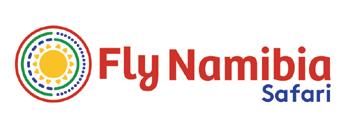
FlyNamibia participated in the world’s largest tourism expo, the ITB in Germany, in early March. Together with the Namibia Tourism Board and several other tourism operators, FlyNamibia's team had three full days of back-to-back meetings with global tourism operators to promote Namibia as the ultimate travel destination. Over 10,000 exhibitors from more than 180 countries and regions attended the ITB, with nearly 40,000 visitors drawn to the expo on the first day alone.
The biggest highlight of FlyNamibia's ITB experience was the launch of a new partnership with beloved Namibian personality, EES. He is a Namibian kwaito and hip hop artist known for his unique fusion of African rhythms with western pop and rap beats. EES has released over a dozen albums and won multiple awards for his music, making a name for himself in Namibia, his home country, as well as in Germany, where he currently resides. EES has used his platform to promote Namibian culture and tourism. In Namibia he is an icon, a larger-than-life personality and the perfect fit to become FlyNamibia Safaris' brand ambassador. Through a one-year partnership, FlyNamibia and EES aim to promote Namibia as a holiday spot by sharing its wonders with the world.
Namibia is known as the most iconic and diverse safari destination in Africa, offering visitors endless natural beauty, diverse cultures and remarkable wildlife. FlyNamibia Safari is causing a revolution in the Namibian tourism industry. It enables travellers to significantly cut down the hours needed to reach our vast country’s far-flung destinations, giving them more time to truly discover, enjoy and absorb the wonders of this land of endless horizons, to build more memories and make the most of their Namibian adventure. With FlyNamibia Safari, tourists can easily access the best of Namibia's top destinations, including Sossusvlei, Swakopmund, Twyfelfontein, Damaraland, Etosha National Park and the magnificent Zambezi Region. FlyNamibia Safari operates a Reims F406 aircraft to these destinations from Windhoek. Daily hop-on-hop-off shuttle flights make it possible for tourists to depart directly to their preferred safari destination, without unnecessary stopovers, shortly after landing at Hosea Kutako International Airport.
Through their partnership with EES, FlyNamibia aims to celebrate everything that makes Namibia special and to ensure that Namibians as well as the country’s German core tourism market and the rest of the world join the celebration. Together, FlyNamibia and EES look forward to a year of promoting Namibia as the ultimate travel destination to the world. TNN
Discover the very best of Namibia on a FlyNamibia Safari flight to Namibia's most iconic destinations. Visit FlyNamibia's website for schedules, routes and more information: www.flynamibia.com.na
Photograph Le Roux van SchalkwykWhen various pioneers in the Namibian hospitality sector came together in late 1987, their aim was to pave the way for the creation of a lobby group to speak out for the interests of the tourism accommodation sector, and to see tourism take up a key role in Namibia’s economy.

Fast forward 35 years and much has been achieved: the Namibian tourism industry is one of the three economic pillars in Namibia, and tourism businesses provide an impressive percentage of employment opportunities for Namibians at all skill levels and in all regions. But while much has changed in the tourism landscape over the past 35 years, it is noteworthy that much has stayed the same.
The Hospitality Association of Namibia was initially named the Hotel Association of Namibia. Apart from a few hotels, motels and several guest farms, not much more existed in the way of tourism accommodation prior to Namibia’s independence. Many of HAN’s archived documents are printed newsletters and lever arch files. Computer files and digitised archives slowly replaced the hard copies half-way through HAN’s history. Going through the archive it is astonishing that the


issues, topics and concerns of the hospitality sector in its early years remain very current today.
A case in point, one only needs to reflect on some of the HAN Congress themes over the past three-and-a-half decades to realise how progressive the pioneers were: 20 years ago, HAN members debated whether investing in tourism was a challenge or a gamble. Most of them were convinced that by going the extra mile and being the perfect host, and through cooperation and making tourism everyone’s business, the future for Namibia would be brighter.
Planning today for tourism tomorrow, growth at home through service and co-operation, and with everyone in Destination Namibia aiming for excellence, the pioneers aimed to create a Namibia to be proud of, just as we all do today.
Many ‘old’ HAN members will recognise the congress slogans of the past in the words above, and they will probably still remember tracking the trends in tourism and aiming for sustainable business practices in HAN’s year of maturity in 2008.
HAN hosted a series of special events over the years, for example:
• tourism and mining, to ensure optimal use of the Namibian landscape; some beautiful long-standing partnerships evolved from this event
• tourism and strategic partnerships with other key tourism sectors, such as operations, travel agencies and car rentals, to strengthen the tourism chain and optimise the business flow
• tourism and training in 2010, to increase awareness of the career opportunities in tourism, as well as improving service levels through dedicated training.
The latter is of particular interest again this year. The 2023 HAN Congress once again focuses on training and skills development, this time to address what has become tourism’s biggest challenge globally – the skills deficiency in the travel industry.
Over the years the persistent lobbying of pioneers, including Tom Mutavdzic and Ulf Grünewald, was instrumental in establishing some training institutions for tourism in Namibia in the early 1990s. Such as NATH and the HTC, which later transformed into the Hotel School in Windhoek and resulted in the number of training initiatives for the tourism sector growing from a few short courses and some vocational training to university degree courses. Following HAN’s event in 2010, tourism was introduced as a school subject and until 2017 the Namibian Institute of Educational Development added tourism to some vocational schools across the country.
The 2023 HAN Congress is able to host no less than 20 different training institutions and training options, from universities, colleges and academies to vocational centres, AND business-owned training programs. Their role has never been more important – the world is in dire need of optimally skilled staff to run the travel and tourism sector. There is an urgent need to synergise efforts, to co-operate and to develop skills for everyone’s business.
The focus of the 2023 HAN Congress on Co-creation of a tourism training roadmap for Namibia aims to pave the way for effective, ongoing and optimal skills development programs for young Namibians, to ensure that the leaders of tomorrow are suitably qualified to take Namibia’s tourism sector to greater heights.
Making the tourism industry attractive for aspiring entrepreneurs as an investment, and for young people as a career choice, has become the aim of many companies and associations. They realise that human capital is one of the most important assets to guarantee a sustainable and enjoyable hospitality sector going forward.
Namibia will always have its special challenges as a dry country, but tourism stimulates many desolate regions. HAN has looked at tourism trends at the change of the millennium and again after 2010. In 2013 the Hospitality Association of Namibia celebrated its 25 adventurous years together with the Adventure Travel World Summit, the first event of its kind on the African continent – now already some 10 years ago. Since then HAN has taken its members on a digital highway, and made them surf the tides of change in tourism.
HAN is committed to keep focusing on the needs of Namibia and its people, to ensure that tourism as the only truly sustainable economic sector, grows and thrives in decades to come. TNN
’91: Johnnie Hamman
’92: Tom Mutavdzic
’93: Alfredo Pimenta
’94: André Snyman
’95: Arno Janetzky
’96: Jürgen Raith
’97: Ria von Seydlitz
’98: Udo Weck
’99: Werner Beddies
’00: Ulf Grünewald
’01: Alta Visagie
’02: Floris Narises
’03: Paddy Brearley
’04: Willem de Wet
’05: Manni Goldbeck
’06: Piet Swiegers
’07: Abner Xoagub
‘08: Merrilyn Leippert
‘09: Wolfgang Schenck
’10: Valerie Sparg
’11: Ernst Sauber
’12: André van Rensburg
’13: Janet Wilson-Moore
’14: Heidi Snyman
’15: Christie Benade
‘16: Rudie Putter
’17: Anett Kötting
’18: Albie van Biljon
’19: Micheletti Brothers, Ruggero & Simone
Stefan Wacker
Katja Basler
2013: Wolfgang Balzar
2014: Dot Daiber
2015: Tibor Raith
2016: Mark Pampe
2017: Tristan Boehme
2018: Karl-Heinz & Christelle du Toit Oosthuizen
2019: Jörn Dedig
Sven Thieme
Netumbo Nandi-Ndaitwah (as Minister of Environment and Tourism)
2013: Mathias Lempke
2014: Ginger Mauney
2015: Orlando Haraseb (Wanderlust World Guide)
2016: Elemotho (rhino song)
2017: Wessie van der Westhuizen (NBL)
2018: Dr Rudie & Marelize van Vuuren (Naankuse)
2019: Werner Ewald (Bannerman Resources)

Did they bring any presents? Yes, they did. Are they wise? Indeed they are. Are they windgat? No. Are they your typical bird watchers/guides? Not at all. Do they know everything about birds? No, they know everything about nature, be it birds, bees, flowers, trees, butterflies, reptiles. They do not know that much about rugby, but that makes it so much easier to explain the finer points of the Blue Bulls, not to be corrected by wise-guy Stormer supporters. These are probably all the reasonable nice things I can say about these fellows.
 Text & Photographs Pompie Burger
Text & Photographs Pompie Burger

Maybe I should start at the beginning. I am not a birdwatcher. Rather a bird lover, and if all else fails you can call me someone who loves taking pictures of birds. Calling me a bird photographer might be a bit rash. Having said that, the wise men can getuig (testify) that I am way below par as far as identifying birds is concerned. All the emails with libraries full of good and not so good pictures of birds that need to be identified. Some even more than once because my memory is not that dazzling and my technical adequacy leaves much to be desired. So a lot of the bird pictures that were identified by the wise men got lost in translation more than once between Swakopmund and Borcher Street.



First and foremost it is actually three wise men and a woman, because Louise does bring so much needed sanity in the family. I have known Steven for many years, since his Hobatere days. Ever since we have been on only one trip together, the Antarctic. Apart from that we have been drinking wine, eating some wonderful meals and discussing long stories about the wonderful things we have achieved in our lifetime – which means we have mainly been drinking and eating. My first trip in Namibia with him and his sons was during the December holiday 2022. We had a very good excuse to do this because we are in the process of constructing, designing, and hopefully completing a field guide of birds in Namibia.
 Yellow-fronted Tinkerbird
African Rail
Yellow-throated Leaflove
Yellow-fronted Tinkerbird
African Rail
Yellow-throated Leaflove
For birding tours, contact Steven Braine: steven@thenaturalistcollection.com
Finally getting to the point of birdwatching taken to the next level was my privilege. What better place to do it than the Zambezi Region. Maybe I shall not bother you with the finer details of where we went or what wine was consumed. If you want to get to the next level you need all your senses, and maybe a bit more. Having a camera, bird book and a vehicle is not enough. My guides for this trip taught me how to use all your senses.
Starting with hearing or listening, I can quite easily identify an African Fish Eagle call, on second thought maybe also a Goaway-bird. Realising that one can go a long way by identifying a bird if you can recognise its call, the next step is to broaden your array of calls. Being technically handicapped, I must confess that one of the wise men is not much better than me. Me venturing into the world of calling birds via technology was always a bit scary for me. It did look and sound very attractive, sorry for the pun. I thought that if you call a bird, it will come flying with the speed of lightning towards you, sitting on the ideal spot to be photographed – meaning close, open, sun from the side and no twigs or branches in between. Not true!
There are a few problems with calling birds. First you need to know where to call which birds. No use calling a Dune Lark when sitting at the Zambezi River. Next problem, if you hear a bird calling and you want it to come into sight or show its face you need to know where to look in your Tamagotchi for the correct bird to call. No use if an Eastern Nicator is calling nearby and you play the call of a Green-capped Eremomela for him. Although, if you wanted to see this Eremomela it might pitch up as a second best if you are lucky.
Seeing is believing. My philosophy has been that I have not seen a bird of which I could not get a proper picture.
This poses a few problems. The wise men can see birds a few kilometres away – to me looking like a dirt spot on my camera. And they will start discussing them in a nonchalant way: “Oh, it is a sub-adult female Ayres’s Hawk-Eagle, might have a bit of abnormal barred window in its left underwing, or it can also be a pale morph.” Having to follow the leader with my 100 kg equipment is difficult, sweating profusely, but Africa is a tough country.

Touching, yes indeed. Having been an avid bird ringer in his day, Steven can tell you how the sensation of touching a Blackcrowned Tchagra is very different from the Brown-crowned Tchagra. One bird in the hand is indeed worth more than two in the bush.
Smelling and tasting – this one you can skip. Although Steven got a sniff of a Leaflove at our camp, and voila, there they were waiting for us. So I had the opportunity to see a bird that I did not even know exists!
Brains. If your surname is Braine you have a bit of an advantage above your fellow birders, especially if you happen to be a Burger. You need to be able to put all these senses together and make sense of what you have and what you’ve got. Being a birder since he was four years old, Steven does have a bit of experience to add to all these senses. The sad thing is that his two sons Sean and Dayne, the other two wise men, are even better, but they had the advantage of a pretty good teacher.
When Helga, Karlien and myself joined them, there was at least a balance of identity and skills. The three wise men and the three stooges. TNN
Phone : + 264 - 64 405 976
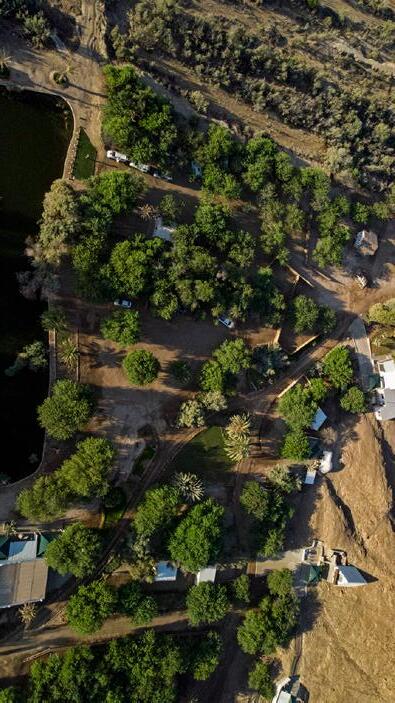

Tucked away in the heart of moon valley lies Goanikontes, a natural paradise that offers an unparalleled adventure for those seeking to explore the beauty of Namibia. With its unique geological formations and stunning scenery, Goanikontes offers an unforgettable experience for nature enthusiasts and history buffs alike. Be sure to visit the otherworldly landscape of the “moon valley” at sunset, and witness the natural beauty of Namibia unfold before your very eyes. And don’t forget to explore the exotic Welwitschia Mirabilis, a plant that can live up to 2000 years old and is found only in the deserts of Namibia. Come and discover the hidden gem of Namibia at Goanikontes.


Scheduled Guided Tours / Fly-in Safaris: A scheduled approach, without compromising on a uniquely personal experience
Private Guided Tours: An expertly planned itinerary to explore our country
Special Interest: For travellers looking for a more focused itinerary centered around a unique passion or interest
Mobile Camping: A comfortable tented camp set up with a touch of adventure, where guests spend their evenings around a campfire under the stars
Adventure Travel: A Namibian experience off the beaten track, offering guests insight into little known tour and safari highlights
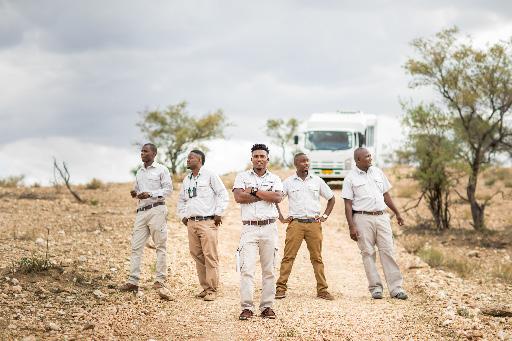
Our Fleet: We own and operate our fleet of vehicles designed and custom-built to suit the Namibian road conditions

Business-to-Business (B2B) solution: Real-time availability and rates for accommodation and tourism products
Self-Drive Travel: On the road to discovering Namibia’s many secrets. We will accommodate your requirements. Accommodation & Car Rental: From luxurious, comfortable or budget-conscious, we have what you are looking for
Linger Longer: Stay for 3 nights, pay for 2
Tel: +264 (0)61 275 300 l Fax: +264 (0)61 263 417
E-mail: info@sense-of-africa.com.na
Web: www.senseofafrica.com/namibia
In the North of Namibia, en route to the untouched Bushman country and the Caprivi region, and only three hours away from the Etosha pan lies our guest farm Dornhügel. We offer you a unique combination of a guest farm with a homely atmosphere, stylish ambience, and rustic farm life. Our eight spacious guestrooms are all individually decorated and surround the lush green courtyard – our Oasis in the middle of the farm.

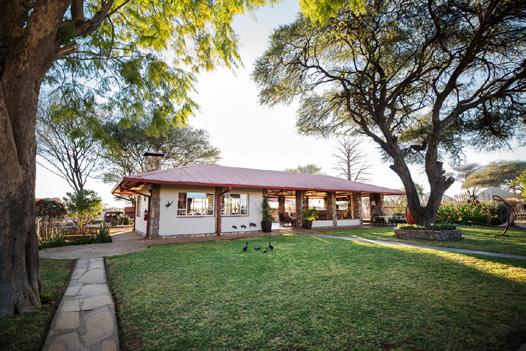
Reservations: reservations.dornhuegel@ travel-weaver.com
Booking Office: +264 (0)67 240 901/3/4
Direct Lodge: +264 (0)67 240 439
Website: www.dornhuegel.com


Namibia is ranked amongst the top-five tourist destinations in the world.

One of the most pressing issues to be resolved in Namibia is the limping state of its tourist industry. Calls for a white paper on tourism to intensify the country's excellent infrastructure and destinations were making headlines recently. The Hotels Association of Namibia (HAN) tried to identify some solutions at their annual congress this year.
In an interview with a Namibian newspaper the chairperson of the Association, Arno Janetzky said, "attitudes will have to change" if the industry wants to turn Namibia into an international tourist destination of repute.
A leading news magazine of Germany listed the country as one of the five most "cleanest" countries in the world - political stability, no famine and a low percentage of AIDS cases - making it a sought after international travel destination.
What stops Namibia from becoming the No. 1 travel destination of the world? According to Janetzky the lack of a clearly defined development strategy in the industry prevents it from expanding and contributing more to national income.
Interested parties both in the private as well as in the public sector will have to establish and circumscribe the market in Namibia. Focussing on market-related and specific services of international standards must become a priority for all involved, says Janetzky.

The dreams of the craftsmen of the North were realised in May this year when the Minister for Trade and Industry, Hidipo Hamutenya, officially opened the new craft centre in Okahandja. The dashing new wood-and-thatch centre on Okahandia's main road is the brainchild of the Namibia Mbangura Woodcarving Co-operative and was made possible with the help of the French development organisation, CRIAA, Trans-Namib, Okahandja Municipality and general coordination by the Ministry of Trade and Industry.

“Our people have the talents and capabilities, but they have to be encouraged in order to better the product and eventually export Namibia's special brand of carving", the minister said at the opening ceremony. He pledged the support of his Ministry for further training of the carvers in business matters and technical know-how.
Namibia's newest and most exclusive game ranch, Ongava Lodge, is situated near the southern gate of the Etosha National Park. The Anderson Gate leads from Okaukuejo to Outjo.
The name of the Lodge derives from the local Herero language, meaning "black rhino".

The main lodge, completed at R6 million, accommodates a maximum of 20 guests in free standing twin-bedded units with en suite facilities and air conditioning; combining five star luxury with untouched bushveld.
The Lodge is situated on the privately owned Ongava Game Reserve, covering some thirty three thousand hectares of pristine savannah and bushveld. The Reserve is in the process of being restocked, already boasting some 27 different species of wild African animals.
The Reserve also sports a comfortable tented bush camp, with luxurious linened beds, as well as a trail camp, constructed with Himba-type huts. The huts, comfortably furnished, add to the many different bush experiences on offer at Ongava.
Guests at Ongava will be able to go on nature drives, by day or night, in open vehicles under the guidance of experienced naturalists.
Nature walks and visits to the Etosha National Park are also on the cards. Riding alongside the vast herds of game on horseback promises to be an unforgettable experience made possible through the horseback trails, also on offer at the Lodge. TNN
With the recent opening of the Mbangura Woodcarvers Market in Okahandja, this vital exponent of the Namibian Tourism industry now has an official standing in the country's tourism product. The Mbangura Woodcarvers Market is still open in Okahandja - 30 years later! Read more about Ongava 30 years down the road on page 56.
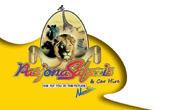










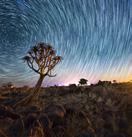


Experience breathtaking views and sunsets from our restaurant and bar. Enjoy exciting activities such as boat cruises, canoeing, forest walks, village tours, and floodplain drives. Our tranquil location in a small riverine forest, on the banks of a backwater lake of the Zambezi River, is just 24km east of Katima Mulilo.








Let FlyNamibia help you discover many different destinations. the wonders of Namibia, connecting you with



